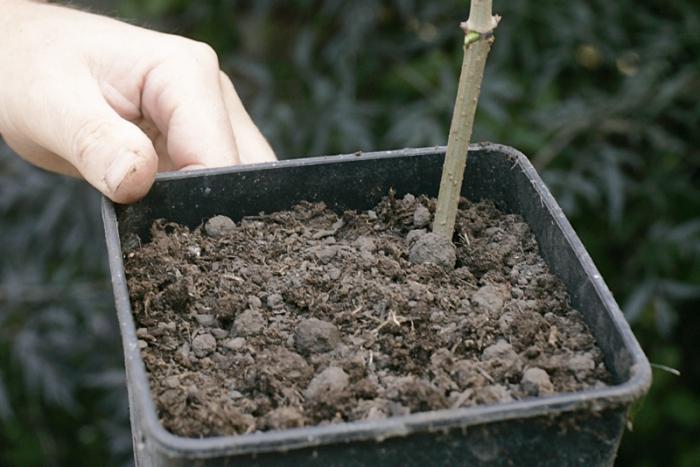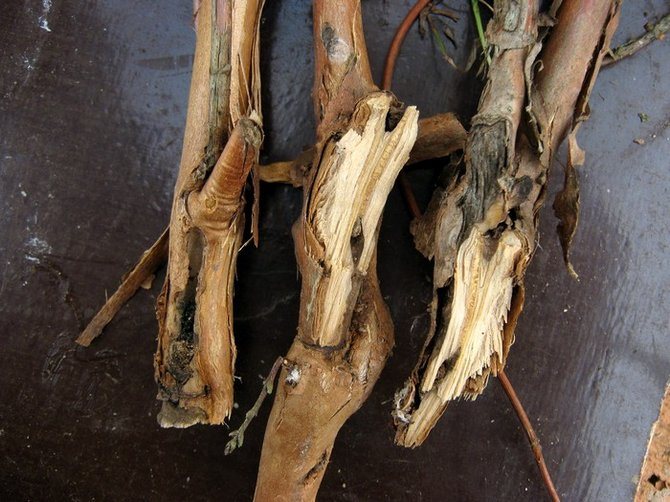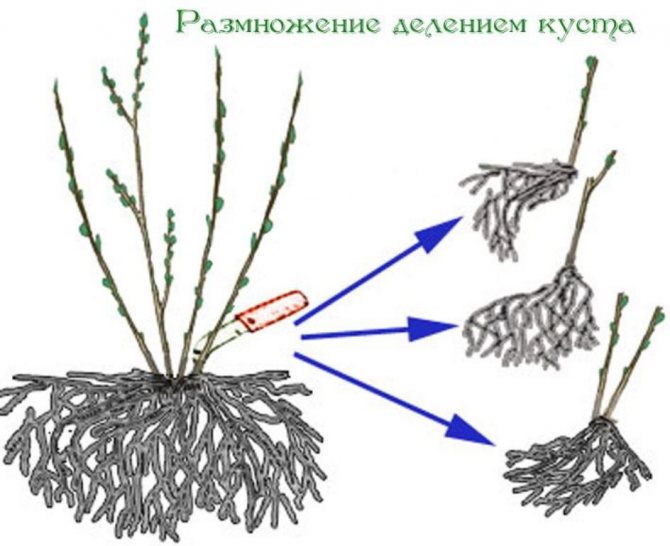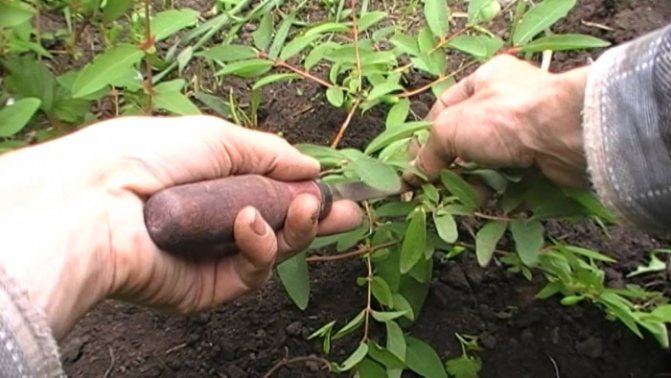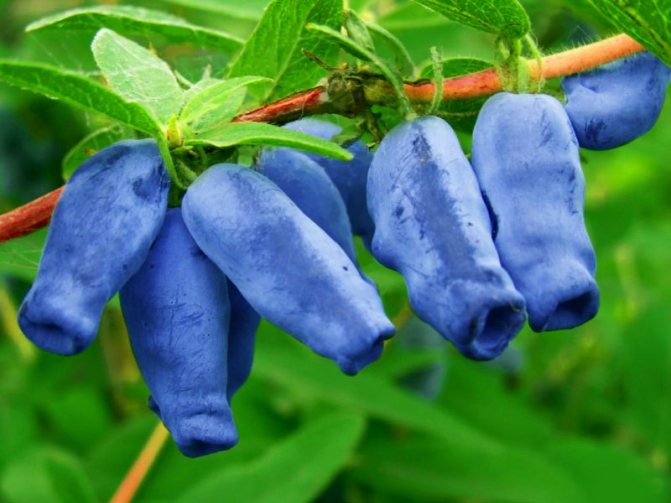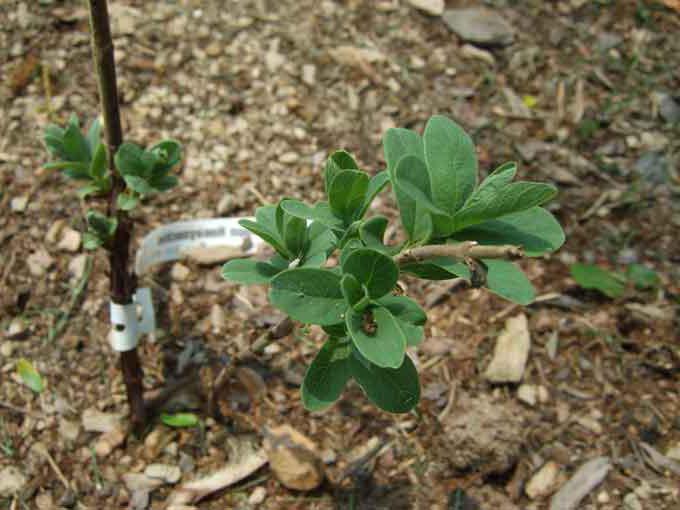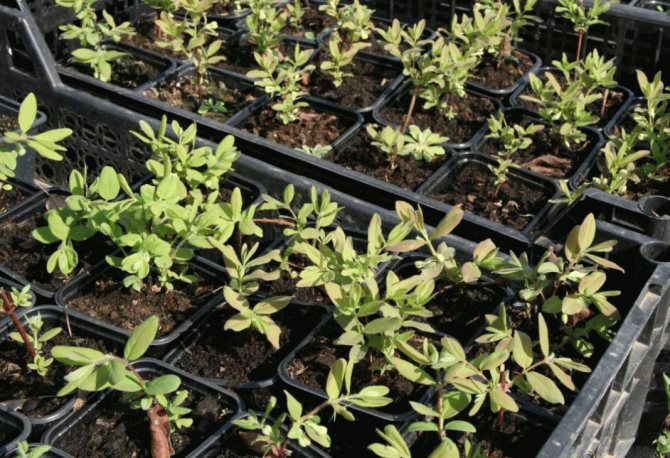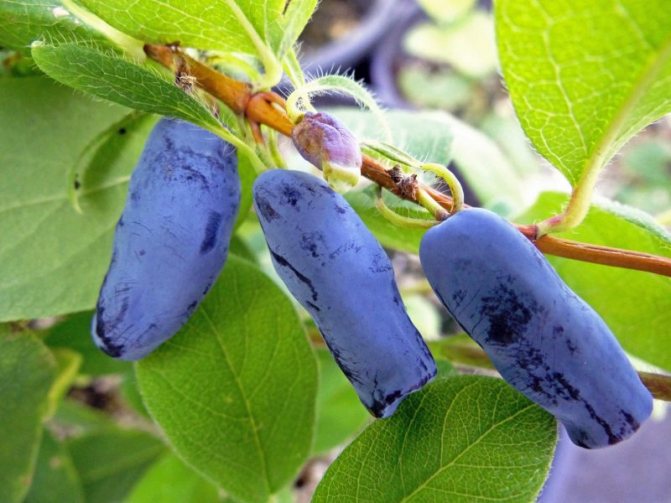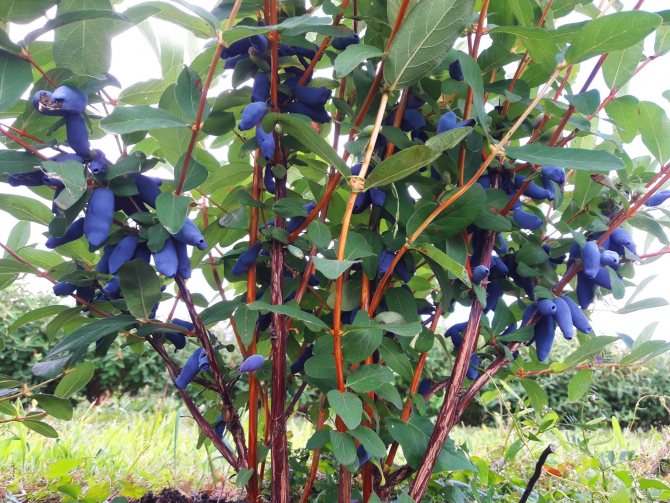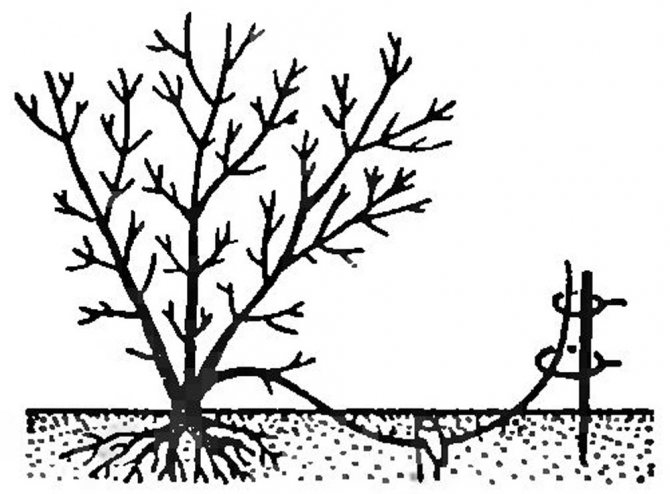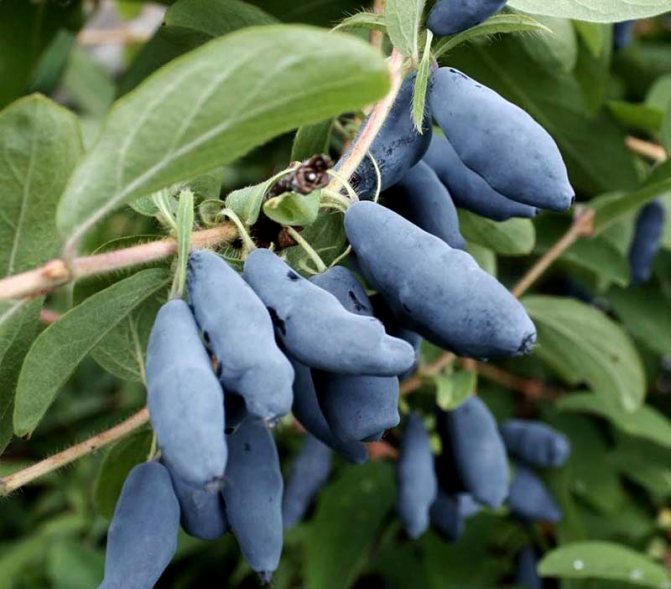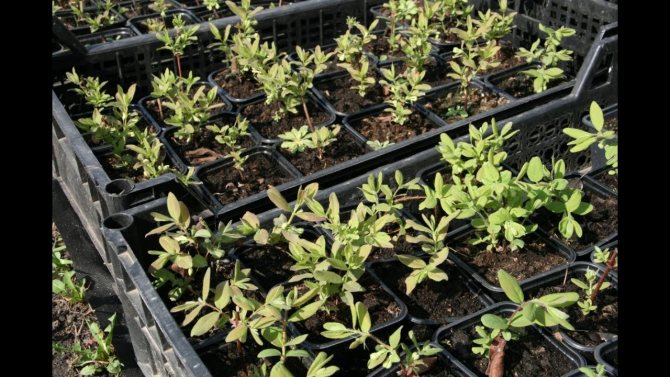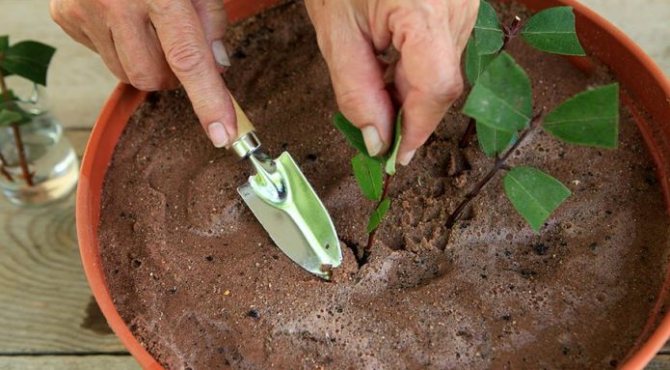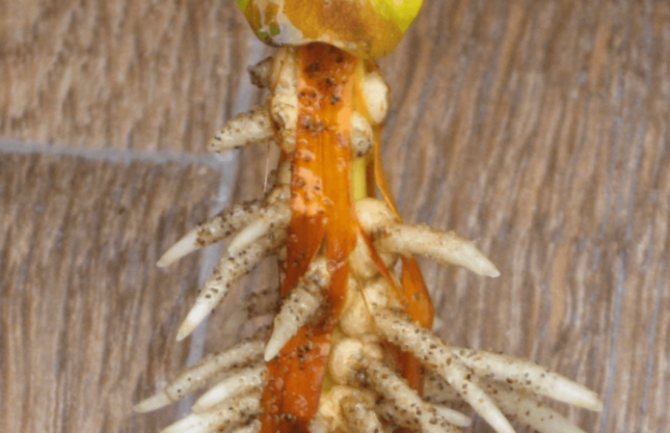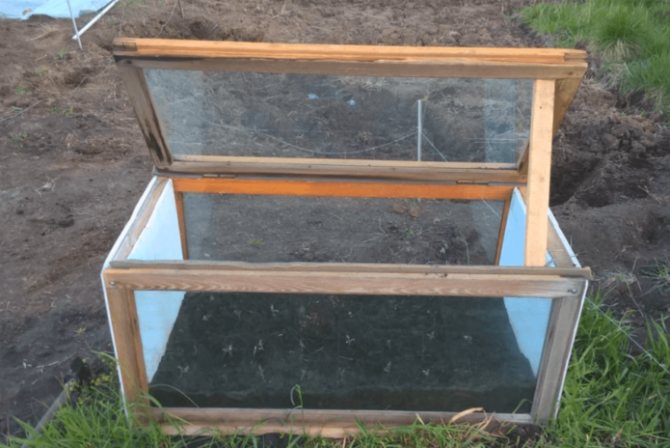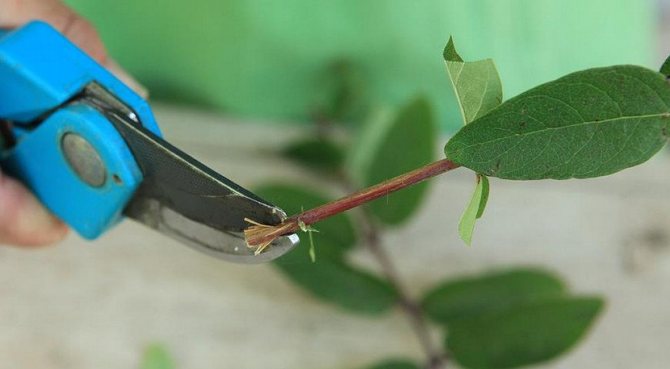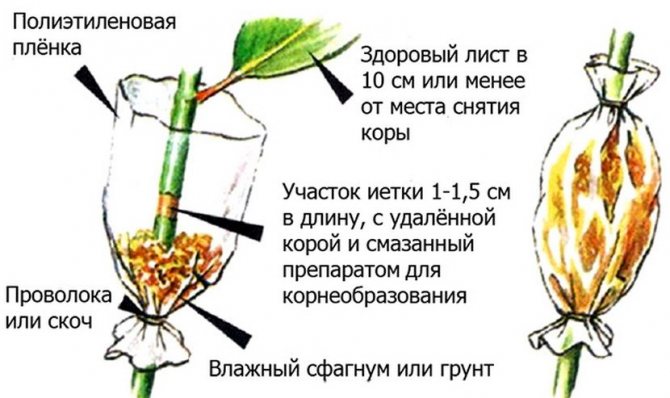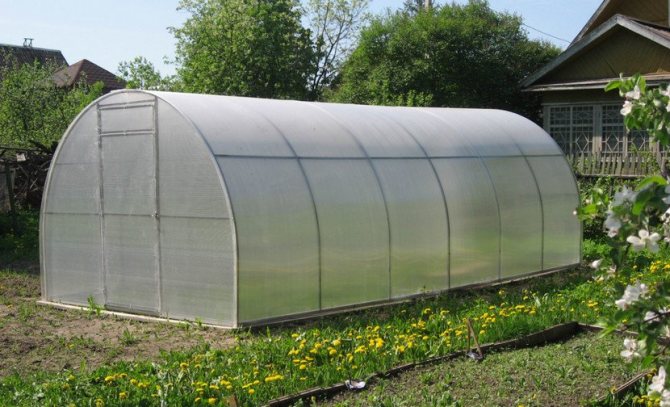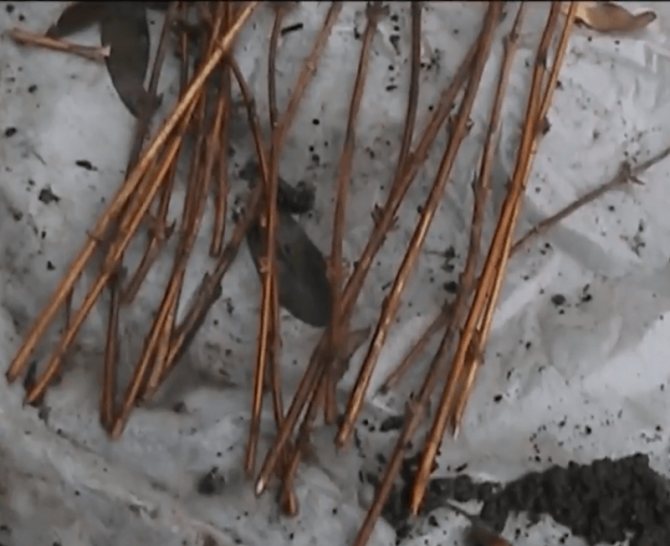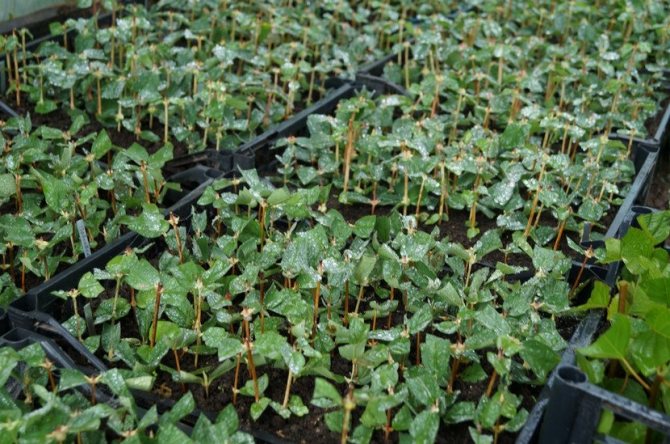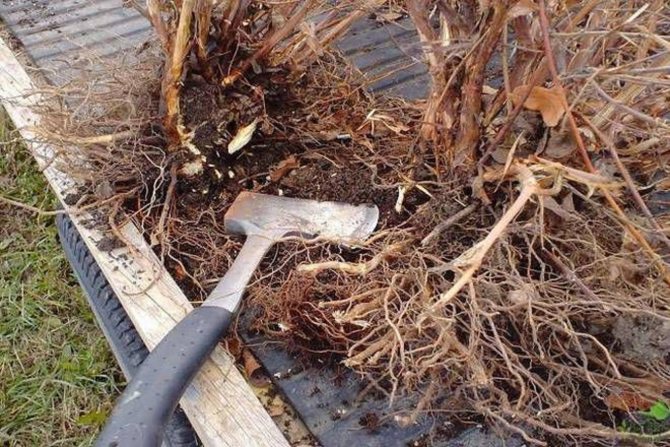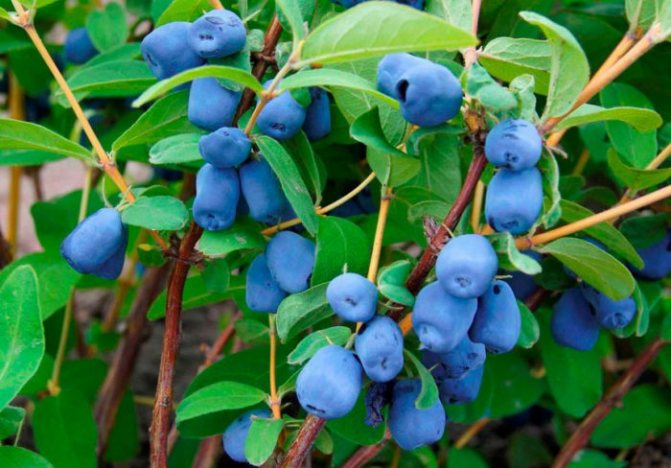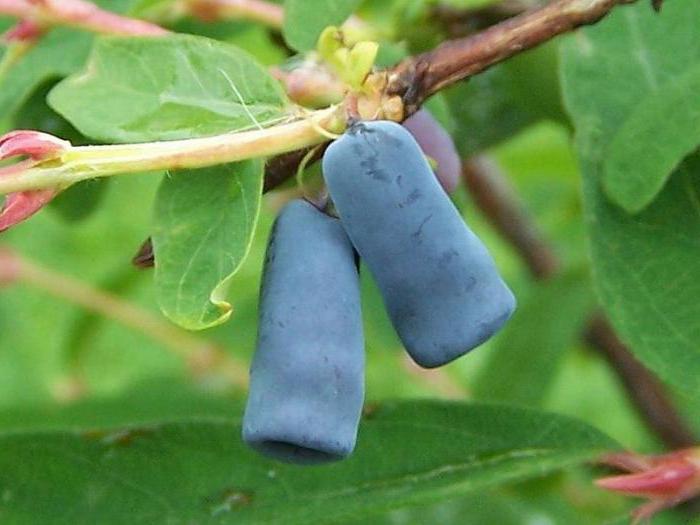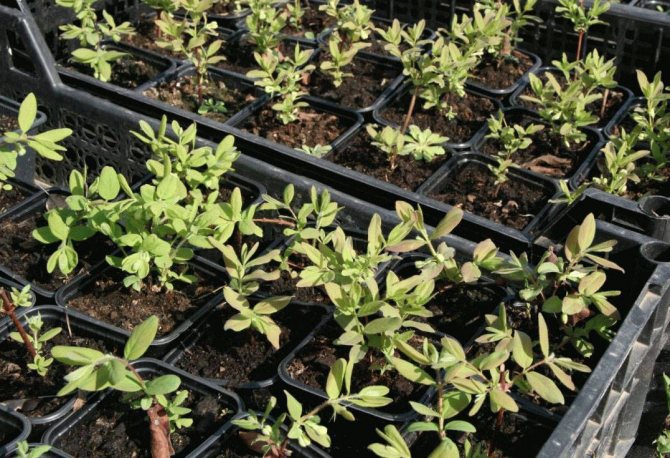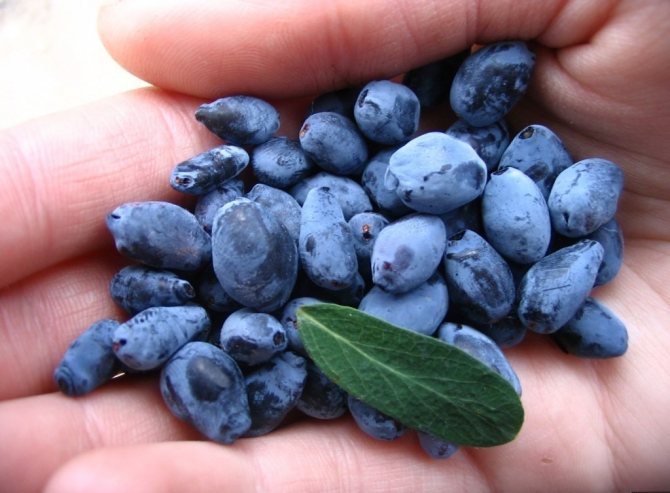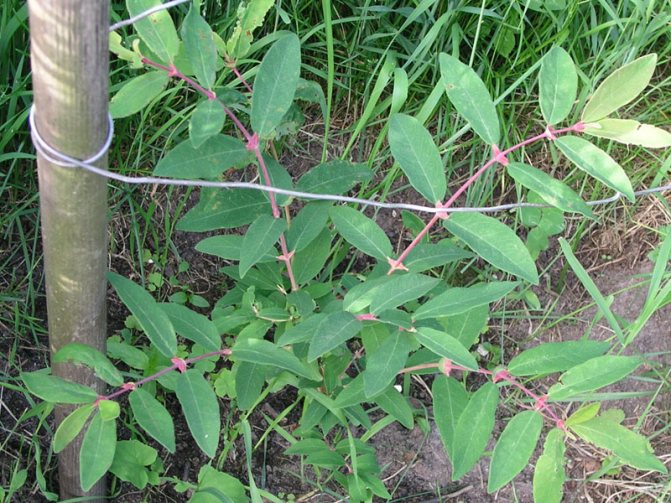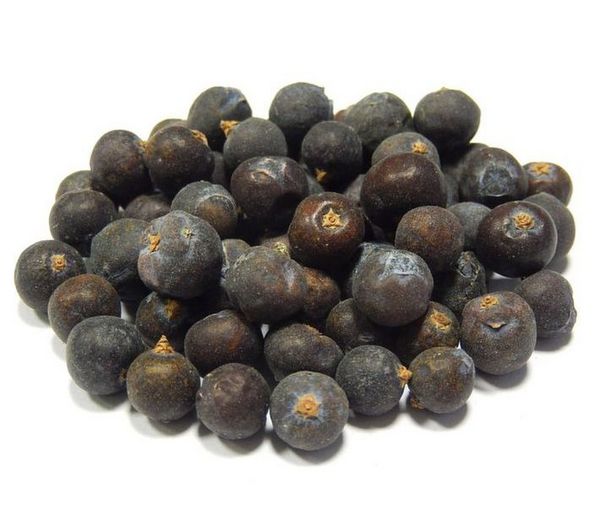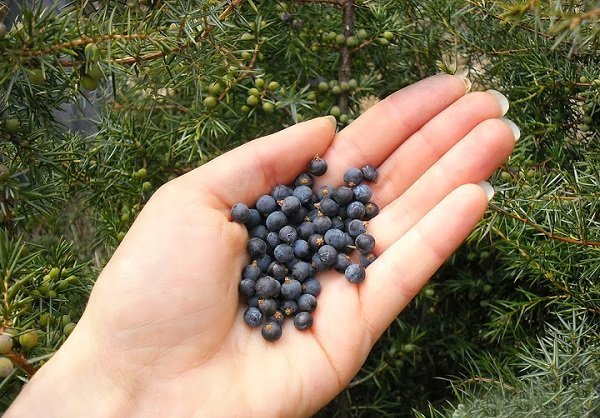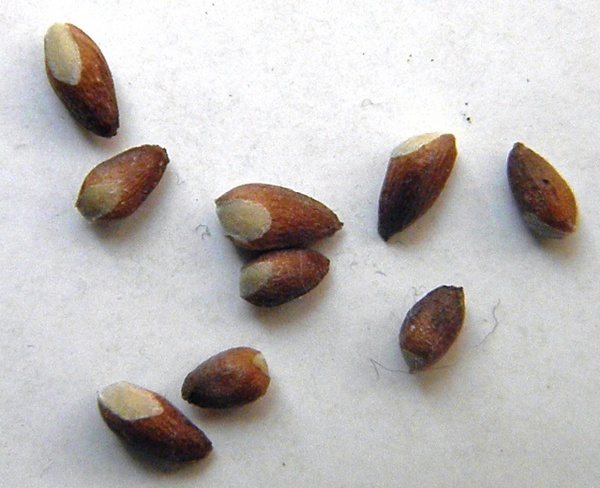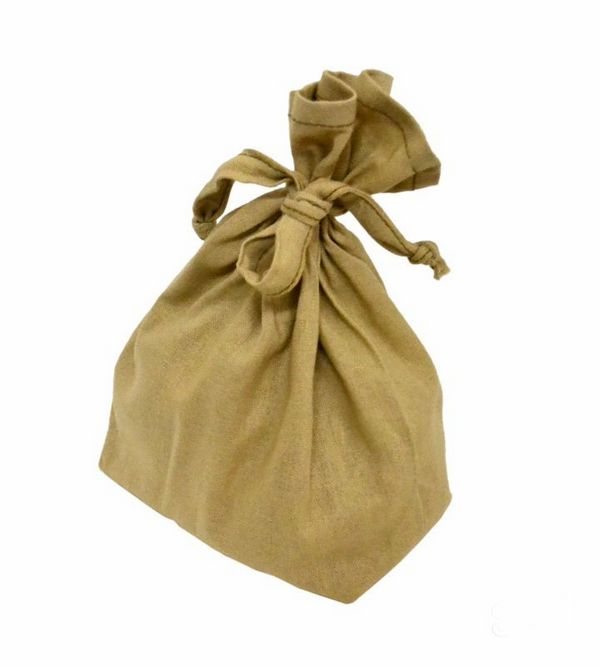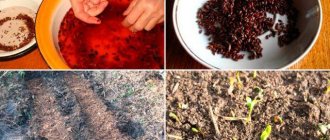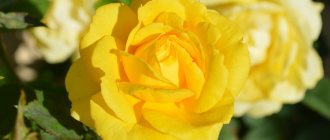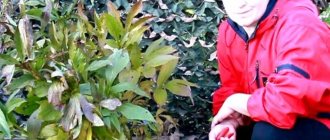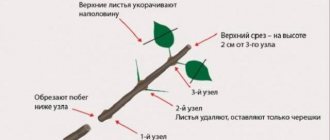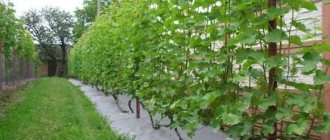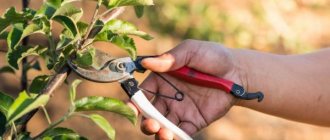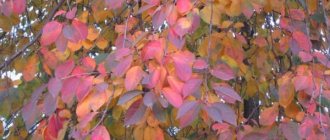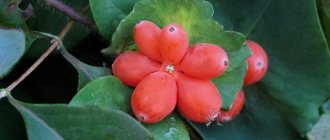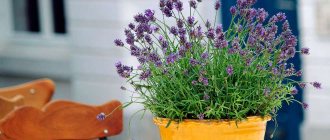Edible honeysuckle literally burst into Russian gardens. Amateurs vying with each other start this berry culture - tasty, healing, extremely plastic and winter-hardy. If it is problematic to purchase planting material in your region, you can grow the seedlings yourself. Vegetative reproduction of honeysuckle at home ensures the preservation of the varietal characteristics of the parent specimen, good survival of the culture, and the rejuvenation of old bushes.
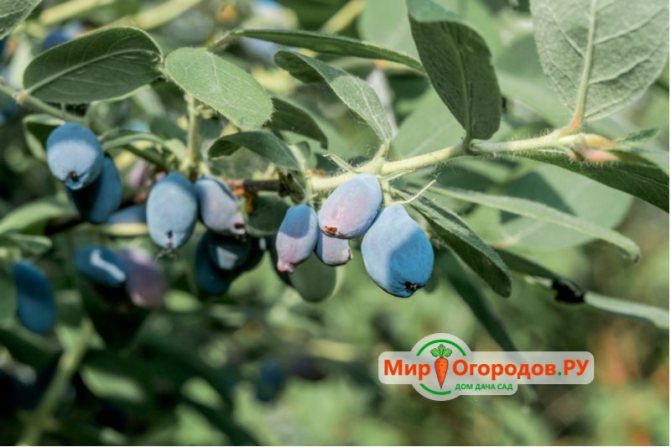
Edible honeysuckle - one of the earliest temperate berries
Breeding timing of honeysuckle
It can be propagated in spring, summer and autumn, depending on the method. To obtain layering, the branches of the bush begin to drop in in the spring after the snow melts or in the fall about a month before the arrival of frost. The division of the bush and further planting of the division can be carried out in the fall, but some time before the cold snap. So the seedlings will not have time to adapt and may die.
The optimal time for reproduction by division is the period of leaf fall (September-October).
Cuttings of the current year in the middle lane are recommended to be collected in May, in cooler regions - in early June. If you prepare them earlier, during the period of active growth of shoots, then the percentage of rooting will decrease. By the time the planting material is cut, the stage of active growth of the bush should stop. The best reference point for harvesting is the end of flowering and the beginning of fruit formation. Lignified cuttings are harvested in the fall in late September or early October after the leaves have fallen, as well as in early spring.
Video about different methods of obtaining new seedlings from the agronomist N.P. Fursov.
Harvesting cuttings
This is the most efficient breeding method. For the propagation of blue honeysuckle, cuttings begin to be harvested simultaneously with the filling of the fruits until they ripen. The shoots ripe for propagation are determined by their breakage. If the shoot does not break when bent, then it should not be used for grafting. It makes no sense to harvest cuttings during the period of active growth (flowering of honeysuckle), since cuttings from immature shoots have a low survival rate due to decay during the rooting process. Late terms of cuttings (end of July) lignified shoots are associated with the risk of death of barely rooted cuttings in winter due to the short preparation period.
The cuttings are rooted in containers with a sandy-peat substrate (ratio 1: 2). The best time to plant cuttings is June. Cuttings are made from overgrown shoots. They are cut into 2-3 internodes up to 10 cm long. A lower cut is made under the kidneys, and the upper one - retreating 1.5 cm up from the node. The lower leaves are removed, and the upper pair is left. The boxes of cuttings are placed in a well-insulated greenhouse. Cuttings must be systematically sprayed, avoiding waterlogging. At the end of autumn, the boxes are moved to the basement or insulated.
Honeysuckle is planted in the second half of September or in spring. Bushes should be located at a distance of one and a half meters from each other. The planting pit should be 60x60x50 cm in size. The planted bushes must be watered and mulched with humus, sawdust or peat. In the future, the mulching process must be periodically repeated, becausegarden honeysuckle has a superficial root system. Sanitary pruning is done to young bushes, and branches are rejuvenated for old ones, pruning them to a strong growth. The plant begins to grow in early April, bloom in early May, and by the end of May the first berries appear. Autumn warming often causes re-blooming. Honeysuckle is winter-hardy, and its flowers can withstand temperatures down to -3 ° C.
Bush transplant rules
Transplanting to a new place allows you to rejuvenate the plant, improve the quality of the berries. All young plantings require competent care, and for fruiting - cross-pollination with other varieties of honeysuckle. The best yield indicators on the site are given by 3-4 different varieties. It is good if the berries differ in taste.
Periodically, honeysuckle needs to be transplanted to a new location. During transplantation, it is convenient to divide the rhizome to obtain new seedlings. The time to move to a new place of residence is summer and early autumn, spring transplantation is undesirable due to the early awakening of the plant, as a result of which it will be difficult for it to adapt to changing conditions.
Before you transplant honeysuckle, you need to consider a few recommendations:
Before planting honeysuckle, it must be borne in mind that for nutrition and growth between individual shrubs, a distance of at least 1.5-2.5 m must be provided. For pollination, the honeysuckle variety is recommended to be placed next to each other.
To increase the number of your favorite berry plants, it is enough to choose one of the indicated breeding methods, and in 1-2 years several fruit-bearing berry bushes will appear on the site. Honeysuckle reacts gratefully to any care, so its reproduction and cultivation is not associated with special difficulties.
Honeysuckle berries are one of the earliest, have a pleasant sweet and sour taste, ripen together and delight gardeners with the first tasty harvest. To increase the number of shrubs in your garden or renew old ones, you can grow new shrubs yourself.
Cuttings - the easiest way, which does not require special skills and abilities. In addition, honeysuckle is propagated by dividing the bush, branches or seeds.
When and how propagation by cuttings is carried out
For green cuttings, annual strong shoots are cut. You need to cut with a sharp knife or blade, secateurs and scissors are not suitable, since they deform the cut site. Then the cut shoots must be divided into small pieces 15 cm long. An important condition is that at least 3-4 pairs of green leaves should remain on each harvested cuttings. Most importantly, the propagation of honeysuckle by cuttings is carried out with the appearance of ripe berries. At this moment, the growth of shoots stops (mid or late June).
In order for the harvested shoots to take root well, the leaves are cut off from them, leaving only one pair at the top of the cutting. The lower cut is shortened to the first kidney. The stalk prepared in this way is planted in a moist soil under a film or in a greenhouse. For the rapid growth of the root system, planting is carried out at an angle, deepening by 1.5-2 cm. Before planting in the ground, the lower cut can be dipped into a growth stimulator. The soil should be light, able to pass air and water well. To do this, take peat and sand in a ratio of 1: 2. The soil is watered and compacted a little.
Optimal growing conditions
To speed up the process of root formation, propagation of honeysuckle by cuttings is carried out in warm weather. In the first days after planting the cuttings, the temperature should be at least 25 degrees. For this reason, young seedlings are placed under a shelter or in a greenhouse. Watered once a week, in hot weather - every 4-5 days.
If everything is done correctly, the first roots will appear in 2 weeks. Then the growth of the root system will be very active.By the end of summer, the seedlings will already be strong and ready to be transplanted to the growing area. After about two years, you will receive new full-grown bushes and you can renew your honeysuckle. Landing in a permanent place in the spring is carried out after the snow melts and the establishment of positive night temperatures.
Reproduction by dividing the bush
If the propagation of honeysuckle by cuttings seems too slow, since it will take 3 years to wait for the berries, then you can divide the bush. This requires a young, not overgrown honeysuckle bush. It is dug up, the roots are carefully cleaned and divided into several parts. To divide, you need a well-sharpened knife. Places of cuts are sprinkled with ash and bushes are planted in prepared holes. Planting should be done in fertile soil. You can add well-rotted humus or compost to the soil. Fresh manure cannot be used, as there is a high probability of root rot and the death of the shrub. This entire operation is carried out before bud break or in the fall. Reproduction in the spring is a more advantageous option, since over the summer the honeysuckle will take root well and will be ready for further wintering.
All gardening lovers are probably familiar with honeysuckle. The original inflorescences of this plant have several color options and can reach a length of up to five centimeters. This article will consider the care of this vine, as well as the propagation of honeysuckle by green cuttings, and a little about individual representatives of the species. People have associated this plant with love and fidelity for a long time.
Conditions for successful breeding of honeysuckle
Fired up with ideas to start honeysuckle, but not fully understanding the intricacies of its cultivation, gardeners are often disillusioned with culture. It seems that they did everything right, they provided care, and the plant refuses to bear fruit or gives few berries, and even those are bitter. To get high-quality planting material, and then a fruitful berry, it is not enough to know how to propagate honeysuckle. An obligatory plus to the technique is knowledge of the biological characteristics of the plant.
- The most important condition for the yield and taste of berries is cross-pollination of different varieties of honeysuckle (at least 3-4) located in close proximity to each other. It is desirable that in the garden collection there are varieties with different ripening periods, dessert, sweet and sour, with a piquant taste.
- For high yields, plant your shrub in an open, sunny location. The preferred landing pattern is not in rows, but in curtains. The large blooming area attracts bumblebees, and these are the most effective pollinators of the tubular honeysuckle flowers.
- For vegetative propagation, choose young uterine honeysuckle bushes with good vigor and no visible signs of disease.
- At the first stage of reproduction, the main task is to stimulate root formation. This requires a favorable thermal regime, high soil and air humidity, shading from the bright sun. In fact, these are the greenhouse conditions that are necessary to leave the nascent life.
- Grown up seedlings need growing, hardening, adaptation to growing conditions in an open environment. During this period, a viable root system is formed, the plant acquires immunity. The optimal age for transplanting a seedling to a permanent place is 2-3 years.
General information
Before studying the propagation of honeysuckle by green cuttings, it is necessary to find out what kind of plant it is and where it came from in our gardens. In the wild, it can be found in the Caucasus and southern Europe.
The flowers give off a pleasant fresh scent, which is greatly enhanced with the onset of the evening. Leaves are dark green on one side and bluish on the seamy surface. Flowers are replaced by small red berries. The life span of this plant can be fifty years or more.
How to plant
Honeysuckle propagation by edible cuttings is carried out using a soil mixture of a special composition. To prepare it, you need peat and sand. They are mixed in a 1x3 ratio. It is best to grow green planting material in a special cuticle - a box with high sides. The prepared soil mixture is poured into this container, moistened and cuttings are stuck in an inclined position (45 g).
The planting material should be placed in the box in such a way that the distance between the individual plants is at least 5 cm, and between the rows - 10 cm. At the final stage, the box is tightened with film or glass. Cuttings will be well accepted only if the air in the immediate vicinity is sufficiently humid and warm.
In the future, the planting material should be periodically watered and sprayed. Cuttings take root about a month after planting. The next year, in April-May, they are grown. Seedlings obtained in this way begin to bear fruit already in the third year.
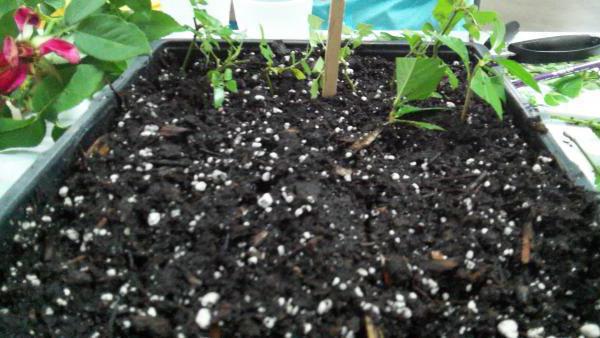

Honeysuckle. Varieties
Recently, in Russian gardens, as well as on Russian tables, the so-called cultivated honeysuckle has firmly established itself. This plant is rightfully the pride of breeders. Honeysuckle, the varieties of which will be considered in this article, not only decorate garden plots, but also bring a tasty and healthy harvest. Among such plants, the following varieties can be noted: Kamchadalka, Dolphin, Altai, Amphora and others.
Honeysuckle Caprifoil is considered a particularly beautiful plant, the reproduction of which will be discussed later in this article.
Propagation of honeysuckle by lignified cuttings in autumn and spring
By autumn, annual growths are covered with bark, woody, but are still suitable for cuttings. However, this time cut the cuttings longer, about 20 cm each, with 3-4 pairs of buds. If the leaves have not yet flown, remove them completely. The cuttings should be bare twigs with buds.
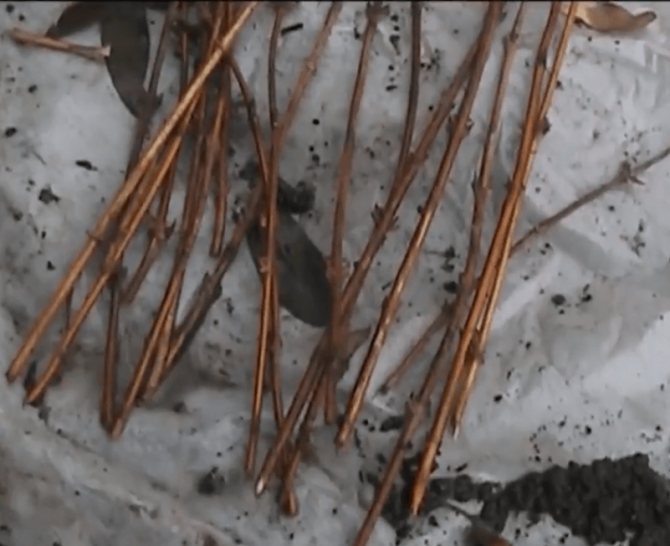

For reproduction in the fall and spring, take a lignified annual shoot without leaves
The best time is September, so that the roots have time to grow before the onset of cold weather. Deepen two lower pairs of buds, that is, half the length or even deeper, you can leave only the upper buds above the surface. As in summer, choose a shady place for rooting, use a loose substrate.
Video: propagation by cuttings and dividing the bush in the fall
The greenhouse effect is not required, since there are no leaves on the cuttings, which evaporate a lot of moisture during summer cuttings. Therefore, it is not necessary to sprinkle and build a greenhouse; it is enough to constantly keep the soil moist. For the winter, cover the bed with cuttings with spruce branches, straw or other breathable materials. Remove them in the spring. Rooting can be considered successful if leaves emerge from the buds.
Honeysuckle bears fruit on annual shoots. Therefore, when rooting by lignified cuttings in spring, not only leaves, but also buds can appear from the buds. Be sure to delete them.
Spring cuttings differ from autumn cuttings only in terms. Cut off annual shoots before budding, you will receive seedlings only by the end of summer. The technology for cutting and planting cuttings is the same as in the fall.
Planting honeysuckle
A young honeysuckle seedling should be planted in a place that will be its permanent home. This plant does not like frequent transplants. For the propagation of honeysuckle by green cuttings to be successful, the plant must be healthy and strong. This is facilitated not only by proper care, but also by proper fit. Before planting, the soil must be well loosened and moistened. Also, fertilizer must be applied to the pit or trench the day before. And if everything is done correctly, then the propagation of honeysuckle by cuttings in the summer will not be difficult.
Green cuttings
Planting the harvested cuttings is not postponed, but carried out as quickly as possible in a prepared substrate. The mixture for planting cuttings consists of one part peat and three parts sand. Cuttings are stuck into a moistened substrate at an angle of 45 ° with a distance between plants in a row of 5 cm. The row spacing is kept at 7-10 cm. After planting, it is necessary to maintain a high humidity not only of the substrate, but also of the air. In this case, the temperature should be in the range from 20 to 25 ° C. To create such conditions, a greenhouse with a film coating or a small glazed greenhouse is needed. Care for cuttings consists of regular watering and spraying through fine nozzles or a simple sprayer. On hot days, the frequency of spraying is increased.
Plant care
Let's figure out now how to care for honeysuckle. First of all, it is necessary to loosen the soil, as well as regularly destroy weeds. If there is little rainfall, then you need to provide the plant with the necessary watering. To do this, create grooves in the shape of a ring at a distance of fifty centimeters from the bush itself. As soon as the water poured into these depressions is absorbed, they are filled up and the soil is mulched over them. Thus, it is possible to produce at least three waterings per season.
Speaking about how to care for honeysuckle, it is also necessary to mention feeding. Feed the honeysuckle twice a year. The first time in the spring, when the buds are blooming, and the second time - at the end of June. It is also important to prune plants on time.
Rooting lignified honeysuckle cuttings in winter
The method will interest those who have the opportunity to get into the garden in January-February, that is, 3-4 months before the onset of heat in your region (without freezing temperatures at night). Cut off the branches that have grown during the past summer, that is, the annual shoots. At home, in a warm place, divide them into cuttings, as for autumn and spring breeding. Make sure that the cut branches are not frozen, they should be light in the cut with a thin green layer under the bark.
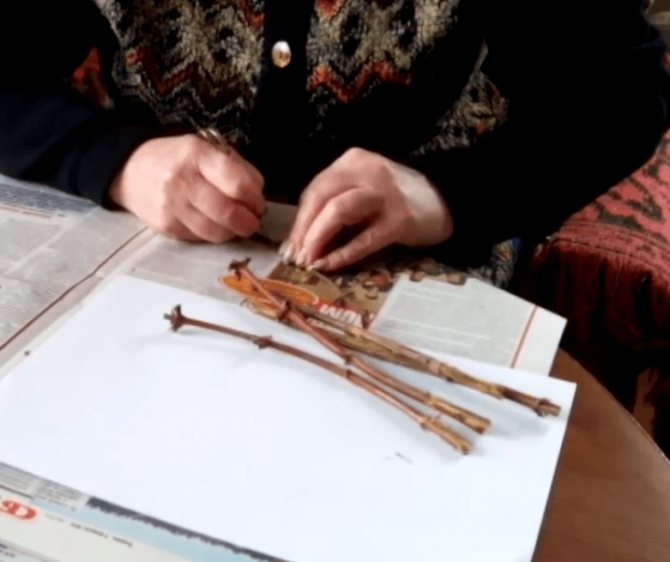

To make the roots appear faster, the lower buds are removed, and scratches are made on the bark at the bottom of the cuttings
In the lower part of each cutting, remove the buds and with a thin knife from the lower edge to a height of 3-5 cm from different sides make several longitudinal cuts in the bark to a depth of 1–1.5 mm. Place the cuttings in water. To do this, use a vessel with opaque walls. Place the sprigs of honeysuckle on the west or east window, the south direction is contraindicated. Change the water 2-3 times a week, first you can throw a pinch of Kornevin or add another root formation stimulant.
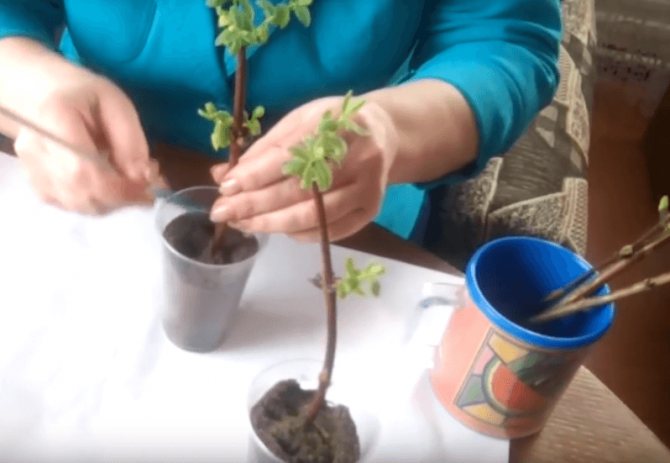

Honeysuckle cuttings woke up, they have leaves and small roots, can be seated in cups
After 2-3 weeks, the rudiments of roots will appear at the sites of cuts in the bark, and leaves will bloom from the buds. Now you can plant the cuttings in cups with loose soil and cover each with a jar, half a plastic bottle, or all at once, for example, with a large plastic bag. We need a greenhouse effect, because the leaves are already there, they evaporate moisture, and the roots are still small and cannot actively supply the plant with water.
Honeysuckle cuttings (green cuttings)
To get green cuttings, it is necessary to cut those shoots that have appeared in the current year, but have not yet had time to wood. Moreover, this should be done in mid-May, after the bush has completely faded, and the very first green berries have appeared. If you cut the cuttings ahead of time, then, most likely, they will not take root, and late cut specimens will not form a healthy plant, since their root system will develop very poorly.
So that the propagation of honeysuckle by cuttings in summer is successful, the shoots are cut obliquely on a cool day and in the morning. Better if the weather is cloudy. Each shoot will give you several cuttings.
Each specimen must be at least seven and no more than twelve centimeters long and have three buds. The top leaves are best cut in half. This is done in order to reduce the amount of moisture that can evaporate.
After all the preparatory measures, the cuttings are soaked in water or in a solution of substances that stimulate the formation of the root system. There they spend the whole day and only after that they can be planted in the ground in one of three existing ways.
Propagation of edible honeysuckle in order to obtain a large number of cuttings with a developed root system (for example, for sale) requires the use of a cuttings. This is a box that consists of four planks and has no bottom. Its size can be any. The outer surface of this box is upholstered with insulation. A drainage is placed inside, on top of which a soil mixture of earth, sand and peat is poured. A layer of river sand is applied to the very top, the thickness of which is about three centimeters. All this is well watered, and then, armed with a stick or even just a ballpoint pen, they make holes that are located at a distance of five centimeters from each other. Cuttings are placed in these holes, compacted with earth and watered. This whole bed is wrapped in foil.
The second way is somewhat simpler. It involves the use of an ordinary square-shaped wooden box, the side of which is fifty centimeters. It is filled with a mixture of four parts of earth and one part of sand. Further, all procedures are performed in the same way as in the first option - watering and making holes. After covering with polyethylene, the box with the cuttings is placed in the shade.
And, finally, the third planting option, which is also the simplest, is planting cuttings in open ground, followed by covering them with a plastic bottle.
In all planting options, cuttings should be regularly watered and provided with fresh air.
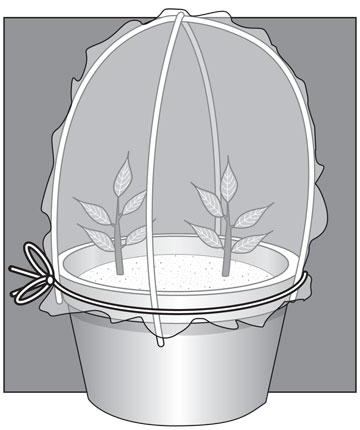

You can ventilate the plants in various ways, but do not rush to completely unfold and remove the film. It's best to wait until the end of summer with this. For the winter, seedlings are well covered with fallen leaves and snow. In the spring, strong plants are transplanted to where they will grow constantly, and immature plants can be left in the greenhouse for another season.
Learning how to propagate honeysuckle on our own using different methods
Similar articles
Seed propagation of honeysuckle
Autumn transplanting of cuttings into open ground is undesirable, as plants with a weak root system can die from bulging. Therefore, the cuttings are often left in the greenhouse to winter, covering them with spruce branches on top. For some varieties of honeysuckle, spring rearing is used. Well-formed cuttings are planted in a permanent place in the second year. The strongest bushes can give the first weak fruiting already in the third year.
Cuttings are started early in the morning before the dew dries, when the risk of drying the cuttings is minimal. On a cloudy or very cloudy day, work is allowed at later hours. First of all, the strong shoots of the new growth are cut off. Only the central part of the shoot is suitable for cuttings. Each stalk should contain one internode and two pairs of leaves. The standard length of the handle is 7 to 12 cm, and the thickness is about 5 mm. From shoots with short internodes, cuttings are cut with three pairs of leaves. The upper part of the cutting has a straight cut at a distance of 10–15 mm from the first bud, and the lower part has an oblique cut at an angle of 45 °.
How to propagate honeysuckle with seeds?
- How to propagate honeysuckle with horizontal layers?
- Honeysuckle is not only a beautiful garden shrub, especially during its flowering period, but also a very useful plant.Its fruits contain a whole range of useful components: vitamins B and C, iron, pectins, rubidium and antioxidants. From these miraculous and tasty berries, you can cook compote or jam, but the beneficial properties of the fruits are best preserved when they are frozen. That is why this plant is so popular among gardeners. However, many do not know how to propagate honeysuckle in their area. And this can be done in several ways.
- Honeysuckle berries are a fairly rare product in horticultural markets. However, their use is becoming more and more popular, which is associated with their beneficial properties and the special attractiveness of the plant during flowering and fruiting. Honeysuckle can be of two types: bush and curly. The latter option is widely used for decorative purposes to give a special look to the walls of buildings and decorate arches and terraces.
- One of the simplest ways honeysuckle reproduces is by dividing the bush. To do this, either in March or in September, the bush should be dug up and, using a pruner, divided into 2-3 parts (along with the roots). Each resulting bush is planted separately.
- If you have at least one honeysuckle bush at your disposal, you can resort to propagation of honeysuckle by cuttings. In this case, you will keep the variety that you have chosen for yourself once.
- Every two weeks, the container with seeds must be removed and moistened from the spray bottle.
- Seed planting time is October. Until then, care should be taken to keep well-dried fruits in a dry place.
- If you are one of those who have already managed to evaluate all the useful properties of the plant in question, then the question of the reproduction of honeysuckle is probably very relevant for you. Unfortunately, even the best bushes bear fruit for only a few years, and then age, gradually losing yield. But these berries, which appear one of the first in the season, are so tasty and healthy that no one wants to deprive themselves of the pleasure of eating them. Therefore, sooner or later there will be a need to replace the bushes. It is unlikely that you will be able to just go to the market and purchase them, so those who are thinking about updating their plantings will find the following information useful.
Propagation of honeysuckle by cuttings
Green cuttings are well suited for common honeysuckle, blue, golden, Tatar, Tangut, black. Green cuttings of such types of honeysuckle as Alpine, Maak and small-leaved honeysuckle take root poorly.
The lower leaves are carefully cut off so as not to damage the buds. The upper leaves are cut to 2/3 of the leaf blade. These measures reduce moisture loss by helping the cuttings maintain cellular turgor.
Seeds are sown in a diving container, preferably in spring, in a substrate of equal parts of peat, sand and sod land. The seeds are covered with sifted humus or washed sand, the layer of which should not exceed 0.5 cm. The container is covered with glass, and then the propagation of plants by seeds is carried out in a greenhouse or room. Seedlings are dived after the leaves appear. Young plants are planted in open ground in spring.In early spring, even before buds wake up, old branches are removed from mother bushes. Then the soil is loosened under the plants. Some of the young branches are gently tilted to the ground and fixed with hooks. After germination of 6-8-centimeter shoots from the buds, they are earthed 4 cm with moist, loose soil. After about a couple of weeks, the hilling process is repeated, bringing the height of the soil layer to an average of 10 cm. When re-hilling, the layers must be fed with mineral fertilizers or slurry. The cuttings are excavated next spring.
How does honeysuckle reproduce by dividing a bush?
Basic landing conditions
Honeysuckle is a shrub with juicy, tasty and aromatic berries.It is quite easy to distinguish honeysuckle from other plants, because its fruits have a slightly elongated shape, are arranged in pairs, and sometimes they can even grow together with each other. On the territory of Russia, edible honeysuckle is common in Eastern Siberia, Sakhalin and Kamchatka. Sometimes you can find entire plantations dotted with beautiful bright fruits. Depending on the variety, of which, by the way, there are about 14 species on the territory of our country, the berries are sweet, with a slight bitterness or sourness. You can also find original fruits that taste like strawberries or even pineapple. Honeysuckle is a rather unpretentious plant that is resistant to low temperatures. A well-lit place is perfect for planting, the presence of a shade is ideal. It is important to ensure good water flow and avoid stagnation. Experts advise planting several bushes at once, so cross-pollination will occur, which will give a bountiful harvest. The following methods of reproduction of honeysuckle are known: dividing the bush, cuttings, layering or seeds. Seed propagation is recognized as an ineffective method due to the very low germination rate. The most popular are the first two methods.
There is no point in separating bushes over five years old!
For the successful growth and fruiting of honeysuckle, at least three varieties of this berry must grow on your site! Bushes can be propagated with both green and woody cuttings. In the first case, the cuttings are harvested during the period of the appearance of the first green berries, while paying attention that it is not shorter than 7 and not longer than 12 centimeters, and at the same time 2-3 buds should be present on it.
Honeysuckle videos
glav-
Propagation by woody cuttings
If for some reason you did not have time to cut green cuttings, do not rush to get upset. You can propagate the honeysuckle with woody cuttings. It is necessary to cut them off after the leaves fall. This is usually the end of September or the beginning of October. Annual branches are selected that have a minimum of two and a maximum of five internodes. The harvested cuttings are wrapped in wet burlap, dripped with sawdust or sand and stored in a cool place. As soon as spring comes, these blanks are planted in loose soil at an angle of forty-five degrees, leaving only the upper bud above the ground. The first roots should be expected in about three weeks. Unfortunately, the percentage of rooting of such cuttings is not too high and is only 10-20%.
How to propagate honeysuckle by cuttings and dividing a bush
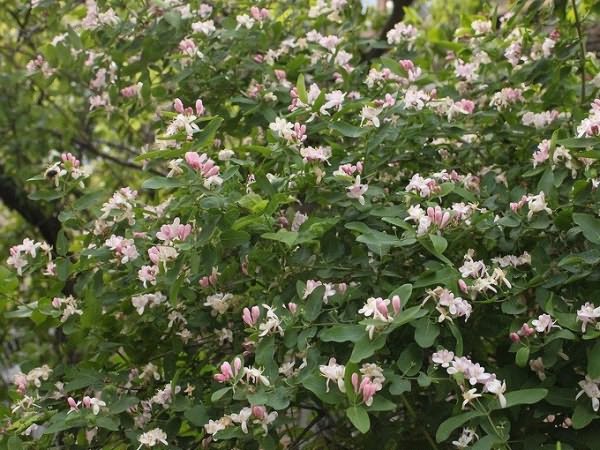

In the spring, pour about 10 cm of soil mixture into a box with high sides, moisten it well and distribute sand and seeds over the surface. Pour another two centimeters of the mixture on top, moisten everything and cover with foil.
What is honeysuckle
It is necessary to sow honeysuckle seeds in the sand; a wide container with sides about 6 centimeters high is best suited for this purpose.
Method 1: grafting
It would seem that it is difficult: if the fetus has bones, then there is no problem in how to propagate honeysuckle. However, in fact, this process is quite laborious and does not always bring the results that you expect.
Method 2: dividing the bush
Cuttings of woody shoots are suitable for Morrow honeysuckle. Cuttings cut in autumn are wrapped in thick damp paper and stored in the basement in boxes with wet sawdust or river sand until spring.
Other breeding methods
There are also other ways to breed honeysuckle. One of them is with layering.


To do this, they dig up and loosen the soil around the bush (they do this in June) and with the help of a curved wire pin the lower branches to the ground. Now they need to be sprinkled with earth and left like that until next spring.
Another easy way is to divide the bush. In early spring or autumn, the bush is dug up.Then, using a secateurs, it should be carefully divided into several parts and seated in different places. This way you can only propagate bushes that are no more than five years old.
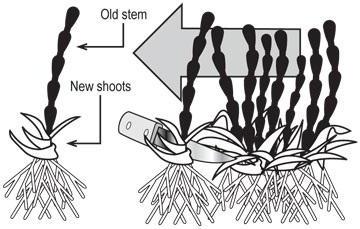

Planting cuttings
This technique is only suitable for a well-developed bush, which can be divided into parts without damaging the entire plant. The main condition is that the procedure should be carried out only before the buds have blossomed, or when the leaves have completely fallen off. Planting holes should be prepared in advance, be sure to water them. Experts recommend shortening all shoots by about one third. At the same time, it is important to give the honeysuckle a year to graft and gain a foothold at the planting site, and to start forming the crown not earlier than this time.
If you have several varieties of honeysuckle growing on your plot, plant them around the same time.
Cuttings with at least 4 buds are cut from annual branches, wrapped in wet paper and covered with sand. They must be stored in a cellar or other cool room, and in early spring the cuttings are planted in the soil so that only one bud remains above the ground. As a rule, the survival rate in this case does not exceed 20 (for comparison, when planting green cuttings, the survival rate reaches 70%).
After the emergence of seedlings, the film should be removed from the box, the bushes should be carefully watered as they dry, and in September, they should be planted in the ground.
Honeysuckle Honeysuckle
Honeysuckle Kaprifol is considered a real decoration of any garden. She is not only very beautiful, but also creates a wonderful aroma in the garden, which intensifies with the onset of the evening. As a result of the fruitful work of breeders, the world saw a huge number of varieties of this vine. They differ among themselves not only in the color of flowers, but also in the type of leaves.
This honeysuckle requires a minimum amount of attention. Be sure to prepare a support for it or plant a plant near a wall or some vertical surface. In any case, a condition is necessary for the vertical growth of a vine, which can reach five meters in a garden plot.
Cuttings of honeysuckle Caprifol is absolutely inappropriate. This is due to the fact that its shoots are able not only to wrap around the support, but also to cling to rough surfaces with small root processes. And this greatly simplifies the entire breeding process.
In this article, we looked at the propagation of honeysuckle by green cuttings, as well as in other ways. Whichever one you choose, if you follow all the simple rules, you will get a wonderful decorative, as well as a very useful plant for your garden.
How to propagate honeysuckle: tips and tricks
The lower part of the shoot with a "heel" (the place of attachment of the young growth to the last year's branch with a part of the bark) is also capable of rooting. With a shortage of cuttings for rooting, you can use the tops of the shoots.
Honeysuckle is characterized by both seed and vegetative propagation. The reproduction of honeysuckle by green cuttings, as well as by shoots and layering, shows great efficiency.
How to propagate honeysuckle with green cuttings?
The height of the honeysuckle bushes reaches two meters, and the diameter of their crown is up to one and a half meters. Honeysuckle loves light, organic-rich soils. This plant does not tolerate waterlogging and does not bear fruit in the shade. Before planting it, the site must be dug deeply and rhizome weeds must be carefully removed. Fertilizers must be added to the soil: 4 kg of manure and 3 kg of peat per 1 square meter.
Breeding honeysuckle with cuttings is a great opportunity to get an excellent result: about 200 cuttings from one bush. First of all, it is necessary to carry out preparatory work: to build special greenhouses so that the cuttings can germinate.To do this, you need to: - prepare an ordinary box equipped with film or glass; - pour a mixture of peat and sand inside in a ratio of 1: 1. Cuttings are cut off in June, when the first berries appear on the bushes. Cutting off is carried out with a sharp knife, always at an angle, while the cut itself should be located directly under the kidney. An important condition for the germination of cuttings is a temperature of + 24-28 ° C and high humidity, at least 90%. With constant watering, shading and airing, the cuttings will germinate in about 4 weeks. Transplantation to a permanent place is possible next fall.
Choose large bushes with a strong root system for dividing - this will ensure that each bush will have approximately the same chances to take up and grow successfully, thanks to the strong root. A big plus of this breeding method is speed: as a rule, the planted bushes bear fruit the next year after planting.
Cuttings should be placed in a container of water for a day, and then planted in the ground. Watering periodically, the cuttings are left in place until spring, and then planted in a place prepared for honeysuckle. However, if you did not have time to cut green cuttings, pay attention to the way in which honeysuckle reproduces from dry shoots - this is done in the middle of autumn.
Select a place to store the box so that it is in the sun for about 6 hours, and in the shade the rest of the time.
The first layer of sand, about two centimeters thick, should be well moistened, then evenly spread the seeds over the tamped surface and sprinkle with sand, again moistened.
When trying to propagate honeysuckle by seeds, you should be prepared for the fact that all its breeding properties will be lost!
In early spring, the lower shoots are covered with soil 15–20 cm. During the period of active growth and on dry summer days, watering and regular hilling are required. The next spring, the shoots are dug up and the rooted shoots are removed for transplantation to a permanent place.
Common mistakes when breeding a honeysuckle bush
It is impossible to learn new things without making mistakes. When planting seedlings is done for the first time, such errors are possible.
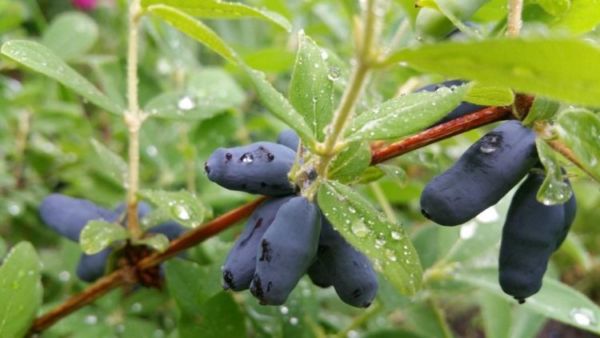

Novice gardeners often make mistakes
When breeding honeysuckle with seeds, after a year, many gardeners seek to transplant the plant into open soil in the autumn season. These actions will lead to the fact that the plant is likely to die, since it is not yet able to protect itself from a sharp drop in temperature during the winter cold season.
On a note! When propagating honeysuckle with the help of green cuttings, larger blanks are taken - this will lead to the plant dying due to poor rooting, because it will try to grow the part that is above the ground, while the root system will suffer.
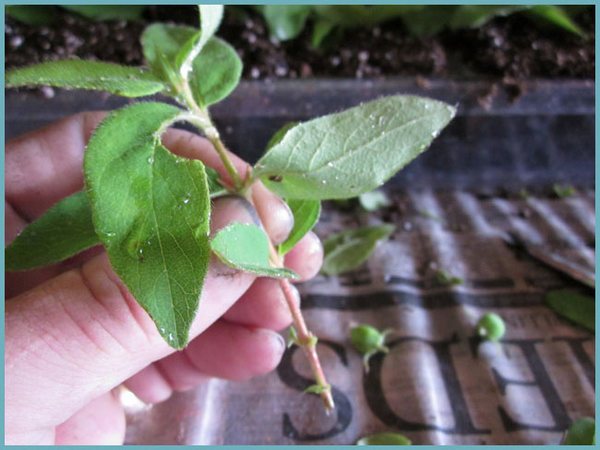

You need to take small cuttings so that the plant throws all its strength on the development of roots
Reproduction with the help of a bush is carried out late, and the first frosts are already approaching. The plant will die when the temperature drops due to insufficient rooting.
It can be concluded that for the reproduction of honeysuckle it will not take much experience and colossal efforts. It is enough to comply with all the requirements for harvesting material for planting, adhere to the optimal time of the year for planting and ensure proper plant care.
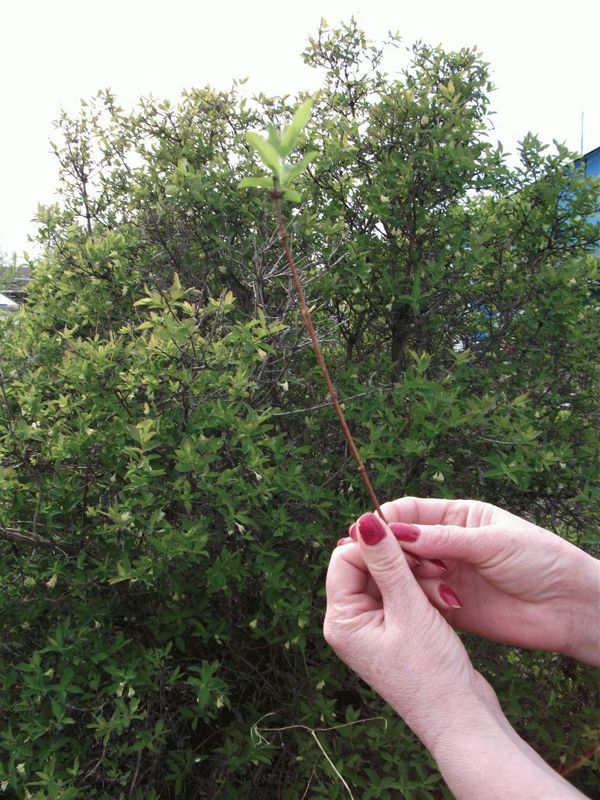

Breeding honeysuckle is easy to do
Diseases and pests of bushes
Honeysuckle rarely gets sick, but aptly. Sometimes pests and diseases attack it so strongly that the plant dies in a matter of weeks. It is in the power of any gardener to prevent the death of a beautiful healthy culture.
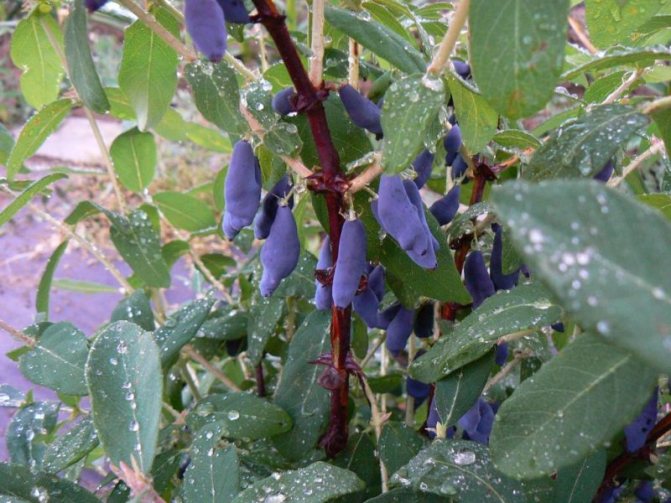

Signs of illness:
- Yellowed leaves. This often happens due to the attack of the honeysuckle aphid.You can fight the pest with garlic, pepper tinctures and systemic insecticides.
- Dark spots, dried leaves. They betray the presence of mites that infect thickened plantings. Shrubs urgently need to be thinned out and treated with insecticides - folk methods are often useless.
- Spoiled unripe berries. This means that the honeysuckle has attacked the pollen wing, which means it should be quickly pollinated with infusions of tomato and potato tops or special chemicals.
- Whitish bloom indicates the presence of powdery mildew. The plant is treated with wood ash and chemical poisons.
- Pale spots on the leaves, black blotches on the veins. Signs of phytovirus infection. Unfortunately, it is impossible to heal the bush. All that remains is to dig up the bush and burn it so as not to infect the rest of the plants in the garden.
Honeysuckle rarely gets sick, it remains green throughout the summer season, pleases the eye with flowers, and then fruits.
Honeysuckle shrubs are grateful, generous plants that respond quickly to any concern. Try to plant honeysuckle on the site, and soon all the neighbors will ask you for cuttings. I wish you rich harvests!
Outdoor care
Caring for honeysuckle is generally easy, because the culture is not demanding at all. But gardeners will have to remember a few rules.
- We do the cropping. In spring, autumn, when there is no bright sun, we remove weak, damaged branches.
- We rejuvenate old shrubs by cutting them about 50 cm from the ground.
- We feed the plant twice a year with organic, mineral fertilizers.
- Water the bush in moderation. We reduce the watering intervals in the heat and the ripening period of the berries. We increase the amount of water. So the fruits will not taste bitter, and the yield will increase.
- After harvesting the fruits, cut off the shoots that have faded in half. We treat the bushes with Bordeaux liquid to prevent fungus.
Many summer residents once a year - in the spring - always spud the bush and add mulch. Such measures help the bush to become more luxuriant, and please the eye with green leaves all summer.
Growing
Honeysuckle grows slowly in the first 3 years of life, so it does not need special care. The mulch layer must be constantly monitored. In regions with a humid climate, it can be a couple of centimeters, in hot ones - up to 20 cm. Particular attention should be paid to watering. Water immediately after planting every day or every other day before rooting. The bush begins to bear fruit early. During the ripening of the crop, it must be watered, otherwise the berries will have a bitter taste. Pour a bucket of water at a time. A layer of mulch will trap moisture and prevent weeds from growing.
Garden honeysuckle
The culture includes edible and blue.
According to the latest taxonomy, these species are combined into one - blue honeysuckle. On their basis, many varieties of edible honeysuckle have been bred. They are pollinated by bees, and are self-fertile. In order to get a harvest, several varieties of this tree need to be planted nearby.
Honeysuckle is a light-loving shrub that tolerates temporary shading. Begins to bear fruit at the age of two, sometimes even at the age of one. They live 80, sometimes 300 years. The plant can withstand frosts up to 50 degrees. Flowers do not freeze at 8 degrees below zero. But it reacts to temporary warming with repeated flowering. It reduces the productivity of the bush.
Honeysuckle is an excellent honey plant.
Edible honeysuckle is a shrub 1 meter high with a spherical crown. Its leaves reach 7 cm, pubescent, especially when young. They have rounded stipules. The bark of honeysuckle is yellow-brown in color. Its distinctive feature is that it exfoliates from the trunk in thin stripes.
Flowers are yellow, funnel-shaped, placed in two. Flowering begins at the end of May. The berries differ in shape, which depends on the variety, and can be round, cylindrical or elliptical. The size of the berries ranges from nine to twelve millimeters. Color - various shades of blue. The pulp is purple.There are small seeds inside.
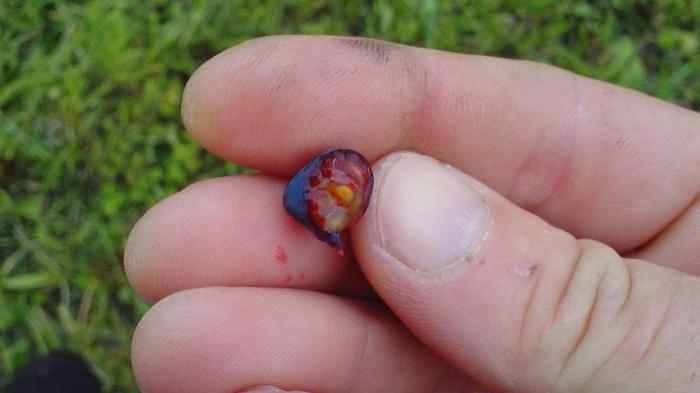

Blue honeysuckle reaches 2 m. The bark is brown. Also exfoliates from the branch. The leaf is elliptical. The flowers are yellowish, bell-shaped, collected in inflorescences. The berries are elliptical, fragrant, with a strong bloom. The berries taste sweet, slightly bitter. The bush has been growing for 80 years.
Video
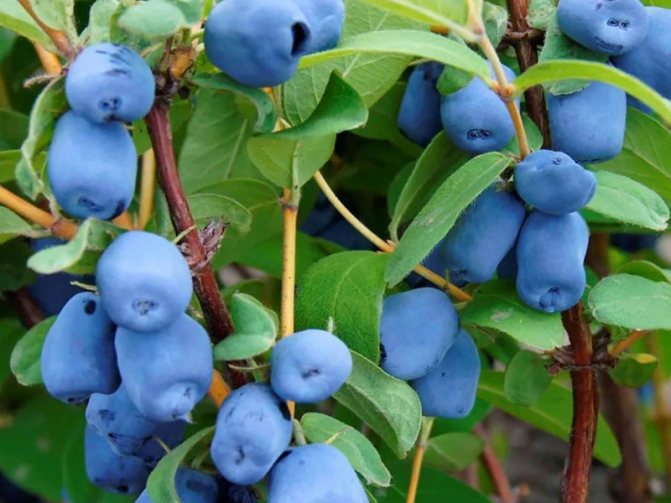

The honeysuckle berries, bluish with a light bloom, attract not only their appearance. They contain many vitamins and minerals. Berries grow on bushes, completely covering the branches. You can find such bushes for planting in specialized farms, but seedlings do not always take root. Therefore, it is worth figuring out how to propagate honeysuckle with your own handsif you want to pick delicious berries in the garden.
The virtues of honeysuckle
- It ripens earlier than all other berries. From the beginning of flowering to the formation of fruits, it takes about 40 days.
- No garter required.
- Unpretentious care.
- Frost resistant. It tolerates frosts down to -40 °. Does not require shelter for the winter. Not afraid during flowering frosts down to -7 °.
- Long lasting. Lives and bears fruit up to 80-100 years. Moreover, its yield increases every year and can be up to 3 kg per bush.
- Ripening of berries is not simultaneous. The fruiting period is extended.
- The taste of the berries is different: with bitterness, sweet and sour, sweet.
- The size of the berries is from 1 cm to 5 cm.
- Fallen berries retain their taste for a week. They do not rot within a week.
- Disease resistant.
Diseases
Usually, honeysuckle is resistant to major diseases. It is damaged by three dozen pests, including sawflies, aphids, false scutes, false mites. They fight with the drugs "Confidor", "Fitoverm".
Among the diseases there are powdery mildew, which can be eliminated with the help of "Fitosporin", olive spot and fungal infections (blackening and drying of branches, shedding of leaves ahead of time).
Fungal diseases are treated with colloidal sulfur and Bordeaux mixture. You do not need to wait for the manifestations of the disease, but to process the trees in spring and autumn for the purpose of prevention.
Generative propagation by seeds
It is recommended mainly for the propagation of decorative honeysuckle, but it can also be used for gardening. Seeds are chosen from the ripe, large, beautiful berries. You can sow them right away, but they are also good for storage. Seeds sprout well, which are 2-4 years old, then stratification is required.
The seeds of honeysuckle are small, so they are buried in the ground only 0.5 cm.You can sow in a box, cover it with a film, but so that it does not touch the soil. The seeds will sprout in about 3 weeks. In the fall, leave the box to winter under the snow, honeysuckle, as a very cold-resistant plant, will not freeze. The second option for reproduction of honeysuckle by seeds: sow them in a box in October-November, so that they do not have time to sprout, and leave them outside. During the winter, they stratify and in the spring they will rise together.
When the seedlings are 2-3 cm high, with 2-3 pairs of leaves, they are dived: they are transplanted into open small beds according to the 5 by 5 cm scheme.Watered all summer, next spring they are planted according to the 20 by 20 cm scheme, and after the year is determined for a permanent place. Honeysuckle from seedlings begins to bear fruit 3-4 seasons after sowing.
Planting
The honeysuckle bush does not tolerate dry air well. If possible, it should be placed near reservoirs or flower beds and lawns that are regularly watered.
It is better to plant bushes in the direction from south to north. With this arrangement, they will be well lit and shade each other from the heat.
In order for the berries to be enough for the whole family, you need to plant at least five bushes, seven can be, although 2-3 of them will be enough for pollination. Moreover, they should be of different varieties. This can be achieved by growing seedlings from seeds. The process is lengthy, but interesting.
Particular attention should be paid to the choice of a landing site. There will be little light for them near the northern wall of the house.The southern ones will not work, they will be very hot there. Better to plant along the path.
Honeysuckle is planted throughout the growing season, but in the spring it is better to refrain from this. During this period, the shoots of the plant are actively growing, and the transplant will interfere with this process. It is better to do this from the last week of September to the second decade of October. In the spring, you can transplant before the buds begin to bloom. They awaken with the first rays of the spring sun.
The plant prefers loam or sandy loam. It is necessary to plant honeysuckle seedlings in low-lying swampy and cool areas. It is advised to plant in places where all plants freeze in winter. If the soil is acidic, you can add chalk or dolomite flour to it. Although honeysuckle can grow in any soil.
The roots are shortened before planting, leaving up to 30 cm.
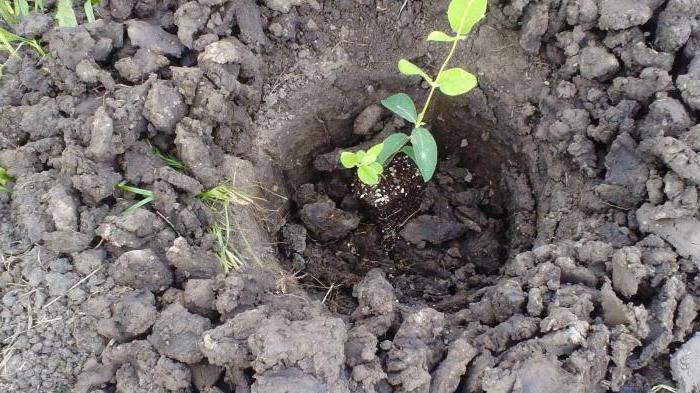

The depth of the planting pit depends on the composition of the soil. If it is light, then it will be 30 cm, and for heavy and wet, 15 cm is enough. The fact is that on such soils, almost the entire root system is close to the surface. Pits for planting are dug with a diameter of 1 m, the distance between them is 2.5-3 m. If the climate is not hot and humid, then it can be planted at a distance of 5 m. It is recommended to plant currants between them, which live much less. At first, she will dominate the site, and when she gets old, she is removed, and the honeysuckle gets additional space for growth.
Organic fertilizers are applied. Having mixed them with the top layer of earth, they are laid on the bottom with a mound. The roots of the bush are spread on it and covered with the rest of the soil. It is very good to make the top layer from forest turf soil (10 cm).
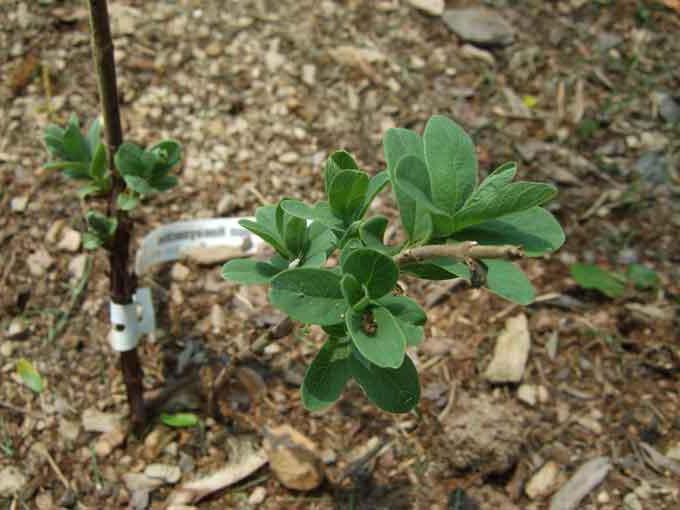

Watering, mulching the trunk circle with leaves.
Useful Tips
To properly propagate honeysuckle, it is useful to heed the advice of experienced gardeners:
- it is very important to harvest green cuttings at the time when green berries begin to form. At this moment, their rooting is maximum;
- if a young plant is obtained from seeds, it is advisable to plant it in open ground only in the next season so that it does not suffer from winter frosts;
- in order to propagate honeysuckle by cuttings, you should not cut too long shoots, otherwise they will use all their strength for the growing season, and not for the formation of the root system;
- it is recommended to plant several varieties of honeysuckle at once on the site, then it will bear fruit well.
conclusions
Honeysuckle is a beautiful plant with healthy fruits. It does not require painstaking processing, excessive care and fertilization. Honeysuckle farming will be interesting for organic farming advocates. It is important to remember that the honeysuckle bush will not tolerate a bare soil layer under it. If you take a close look at the plant, it will certainly delight you with its beauty.
Under production conditions, it is not very convenient to propagate honeysuckle by layering, although many of its varieties willingly allow this to be done.
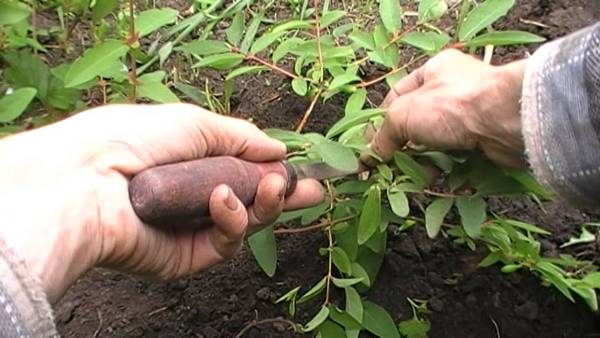

The most effective breeding method for honeysuckle is cuttings
Gardening with an emphasis on decoration often uses grafting of honeysuckle. Cuttings for this method are harvested during the dormant period, they are kept cool, the procedure is carried out in the spring.
The most effective breeding method for honeysuckle is seed propagation and green cuttings.
How does honeysuckle reproduce?
Honeysuckle can grow in the same place for 20 years. It is possible to breed a shrub only after 1 year from the moment of planting, it is important to take into account the subtleties of each method.
Honeysuckle can reproduce in the following ways:
- using seeds;
- layering;
- dividing the bush;
- woody cuttings or green shoots.
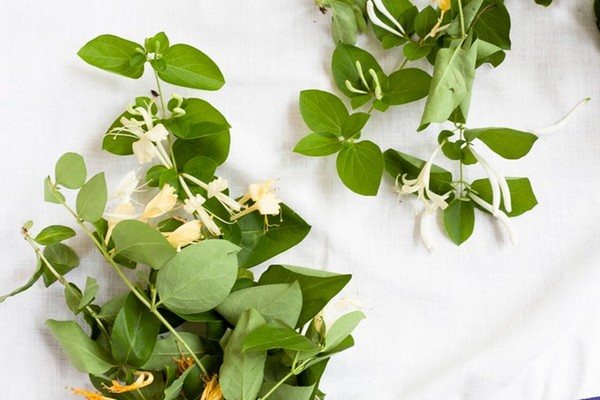

Honeysuckle can reproduce in many ways.
Each method of obtaining new plants should be studied in more detail and the most suitable one should be chosen.
Seed breeding
Honeysuckle seeds can be easily purchased online.Sellers guarantee that the plant will grow quickly and will delight with splendor.
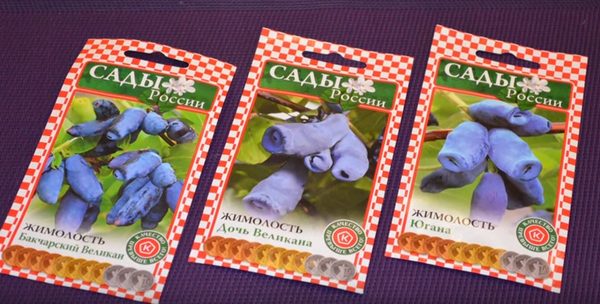

Honeysuckle seeds
You can grow a plant from a seedling at home, but it will take a long time and cause trouble. Such a sprout will differ from the maternal one; one should not hope for the similarity of their qualities. For one hundred percent achievement of the result, it is better to use simplified and time-tested methods.
On a note! If you're anxious to experiment, you can try growing honeysuckle with store-bought material. Get ready to carve out a territory, put in a lot of effort, and be patient.
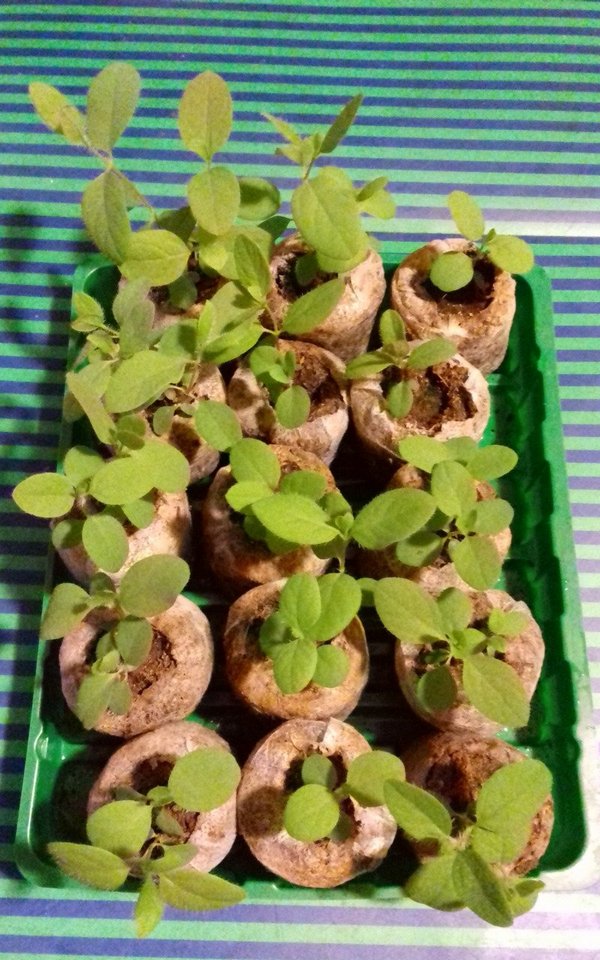

Growing honeysuckle from seeds is not an easy task
Statistics are such that out of 100 sprouts, only 3-5 shrubs are successful, which have the required qualities, tasty fruits of large sizes. The rest of the specimens will upset gardeners with small berries and a bitter taste.
If it is impossible to purchase seedlings, they are subject to self-collection. You can prepare seeds in the following way.
| Steps | Description |
| Large berries are selected that have matured well. |
| Squeeze them with your hands and remove the juice from the fruit as much as possible. |
| What is left must be filled with water. After a certain period of time, the seedlings will remain at the bottom of the container, the peel will float up. Everything that remains at the bottom must be removed, dried and placed in a warm place until it is time for planting. |
| You need to fold the seeds in a bag made of canvas fabric, put them in a warm place until planting. |
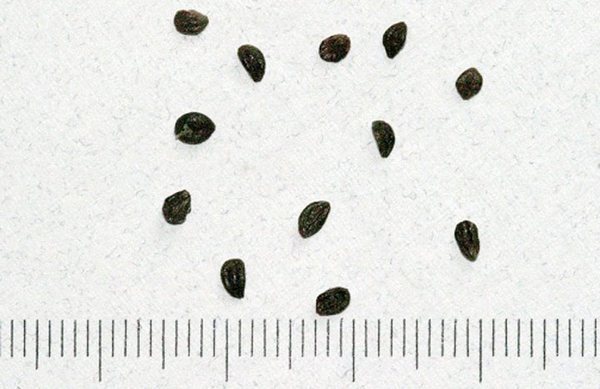

You need to use seeds from large berries
Seed cultivation of a shrub is best done in the spring. Suitable time is March or April. This approach contributes to the rapid germination of the seed, and by the end of the summer period, one can hope for the appearance of the first leaves.
On a note! Initially, it is better to plant seeds in a limited container, after they germinate, you can plant them in open ground.
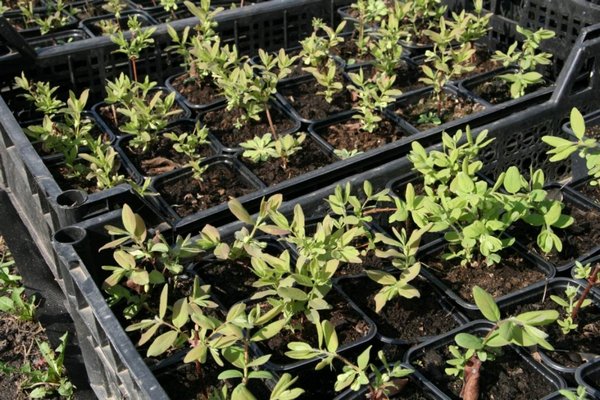

Better to sow honeysuckle in March
Planting in the fall is also permissible. Suitable temperatures range from +1 to + 3 ° C, so on cold winter days, the seeds undergo natural stratification. Such conditions temper the plant, and in the future it will hurt less.
In order to root the seeds, you need to prepare the soil. Align and seal it. The planting depth of seeds should be no more than 5 mm. It doesn't matter how you plant: exactly in rows or in a chaotic manner.


It is important to prepare the ground
The rapid removal of moisture from the soil adversely affects the growth of the roots of the sprout, you need to mulch the territory or cover it with oilcloth.
On a note! In 21-25 days after planting, you can already see the first shoots.
Breeding by layering
Breeding honeysuckle bushes with layering is the easiest way to acquire young plants.
A guide for correct breeding with layering looks like this.
In the spring or summer, new stems are separated in the bush.
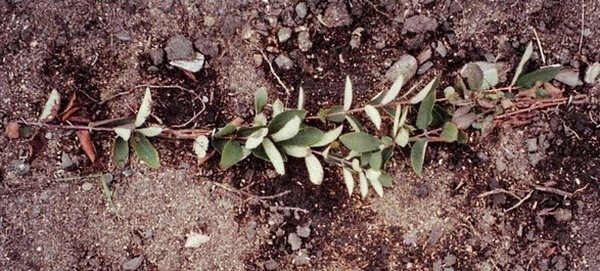

You need to separate the stems in the spring or summer.
A long trench is dug near the designated branches.
The selected shoot is bent to the soil and the base is fixed with a holding object. The sprout is then placed on the bottom of the ditch. It will be good if the kidneys are on top. A root will develop under the buds, the eye will become a young seedling.
When the shoots germinate, they are separated from the mother bush. This is done for the purpose of separate feeding and development of the sprouts.
On a note! Otherwise, they will draw out all the nutrients from the parent bush.
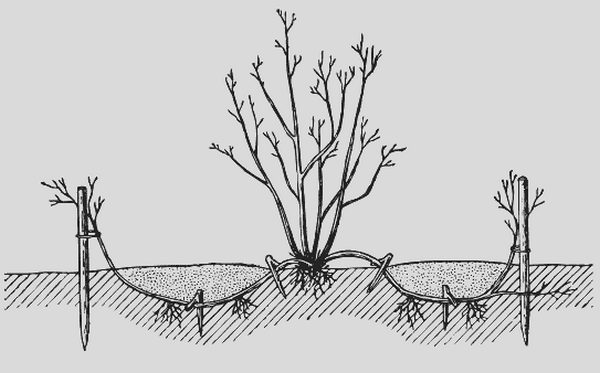

Shoots are separated from the mother liquor after the root has developed
Choice of mother liquor
Reproduction cannot be started without choosing a mother plant. The new plants will be similar to the mother plant in 98 cases out of 100. The decision to grow a seedling in-house should initially be based on observation of the mother plant.The parent hive must have the following characteristics.
- The compactness of the bush. The plant should not look sickly.
- Fruits are large, juicy, shedding of unripe berries and strong crushing during picking are unacceptable.
- It will be a plus - dry tearing and ripening of fruits at the same time.
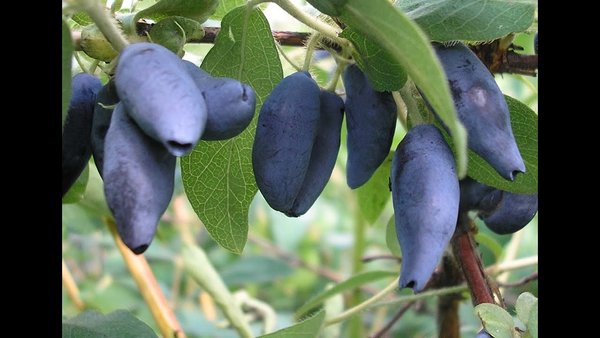

The parent bush must have large fruits
Cuttings
Method number 1. Breeding with green cuttings
The plant can be propagated using cuttings of the current season. Cutting cuttings before flowering is likely to result in further death. A stalk cut after harvesting the fruit will have bad roots, and their development will be defective.
On a note! A suitable period for preparing cuttings will be the time after the formation of green fruits - usually this is the second half of May.
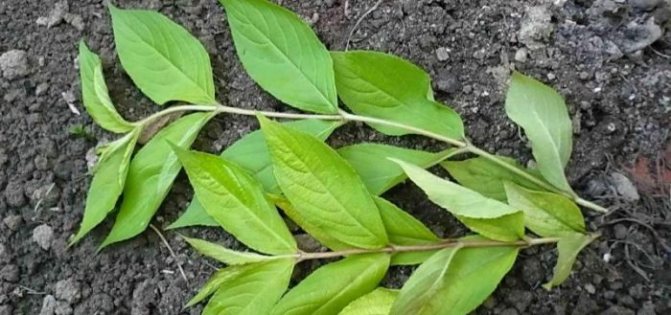

Honeysuckle stalk
Terms of cuttings
Sprouts that break when you try to bend them are ready for the grafting procedure. Cutting of green cuttings is carried out towards the end of the flowering of the bush and at the time of the appearance of green berries. Harvesting cuttings during the period of intensive growth and development until the appearance of the first fruit formations guarantees further survival by only 50-60%. The formation of sprouts during this period is not yet over, they will not be able to take root, and decay will occur due to the large amount of moisture.
On a note! The chance of survival of cuttings made from stiff shoots is greater, but they will not have time to get ready for the winter period.
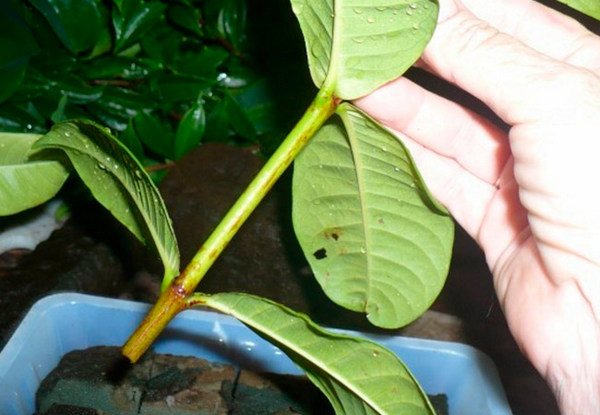

You need to use those cuttings that break easily
Cutting cuttings
Cutting cuttings is best done in the morning, when the air is still cool. In the bush, the strongest shoots are selected and cut. An important point - we need the shoots of this year. For cuttings, an average shoot is required, the presence of two pairs of leaves and at least one internode will be a plus. The stalk should be 12 cm long and 0.5 cm in diameter.
On a note! If the distance between the nodes of the shoot is small, you need the cutting to have three nodes.
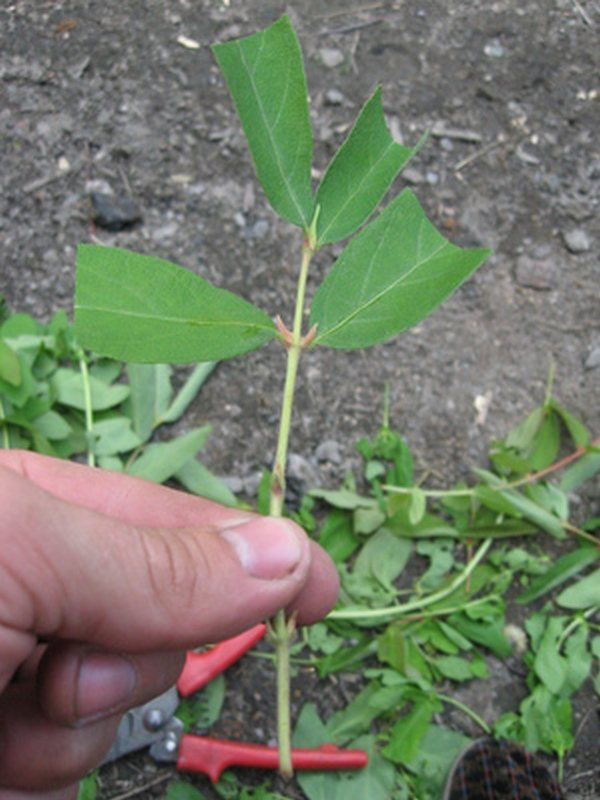

It is better to cut off the cuttings in the morning.
It is necessary to maintain an indent from the kidneys of 15 mm, then a horizontal cut is performed. The cut from the bottom should be at a 45 ° angle. There should be no leaves in the lower nodes, they are removed. To stimulate rooting in the future, it is possible to use special biostimulants on the lower part of the cutting. You can buy them at any gardening store.
Planting cuttings
Planting in the soil is the next most important stage after cutting the cuttings, it must be done immediately. The soil should be composed of a mixture of sand and peat in a 3: 1 ratio.
The success of cuttings is guaranteed if the high humidity of the air is 85% and the soil mixture is maintained. A temperature regime of 25 ° C must be ensured. This mode must be maintained in a greenhouse covered with a film, or a glazed greenhouse. Spraying and watering should be done regularly, especially in hot weather.
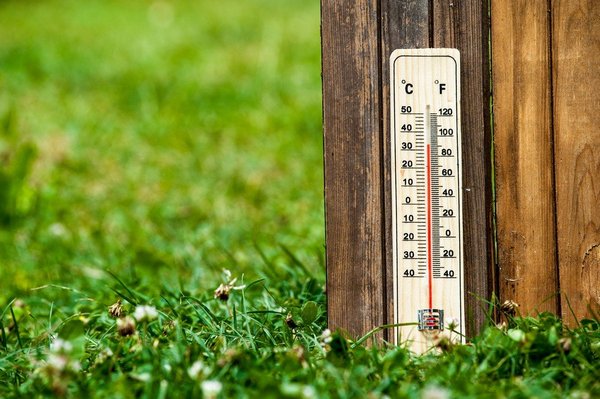

It is important that the air temperature is at least 25 degrees Celsius.
On a note! With proper observance of all conditions, the root system will develop 10 days after disembarkation.
Now it is necessary to "harden" the cuttings - for this purpose, the door to the greenhouse is opened for 40 minutes.
Spraying now needs to be carried out longer, but the interval between procedures should also be increased. Loosening the soil, weeding and watering in dry weather - that's all the simple care of cuttings that have developed a root system.
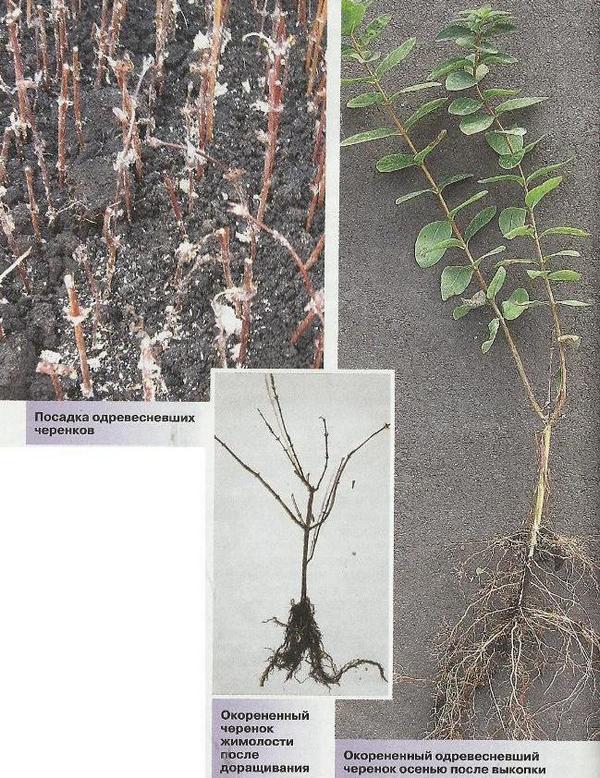

Within 10 days, the cutting will take root
In the spring, you will need to remove flowers from the plant to enhance its growth.
Rooting cuttings in a greenhouse
After rooting, the cuttings need to grow for another 1-2 years in the same place. Densely planted cuttings for growing need to be transplanted. In the autumn, it is unacceptable to carry out this procedure, since this can lead to the death of cuttings due to the exposure of the soil layer.
On a note! The best transplant period is late April or early May.
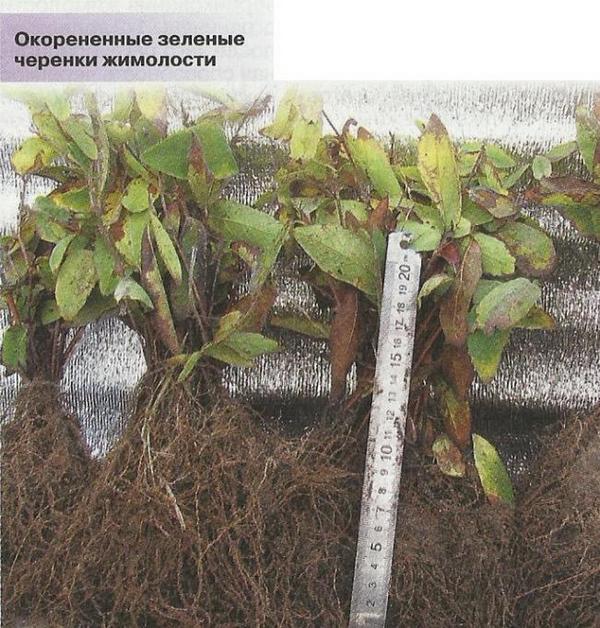

Honeysuckle cuttings after growing
After 2 years, you can expect the appearance of strong plants. In the autumn period, their growth can reach 35 cm. Strong seedlings that do not suffer from diseases require transplantation to a permanent place, and weaker specimens are better to grow. After three years, flowering of plants and the appearance of the first fruits is possible.
The care plan for planted cuttings is straightforward. The main thing is to water and air the plants in a timely manner. Cuttings that are rooted do not need to be opened until the end of the warm season. During the wintering period, the plants are insulated with a layer of fallen leaves, and then with snow. When spring comes, the cuttings open completely.
On a note! Seedlings that have grown stronger can be transplanted to a permanent place after a couple of months.
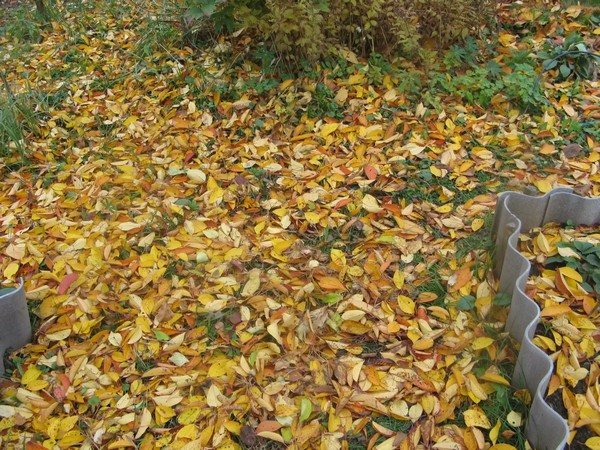

Small seedlings need to be insulated with fallen leaves.
Method number 2. Breeding with lignified cuttings
This method is relevant for use in the middle of the autumn period. Cuttings are harvested from one-year branches. An important point is the presence of at least 2-3 buds on each branch. Cuttings that are stiff should be wrapped in damp paper and buried in sand or crushed sawdust. Until the onset of spring, they are stored in cool conditions.
At the end of March, they are planted in loose, well-moistened soil at an angle of 45 °.
On a note! Root development will begin in about 2-2.5 weeks.
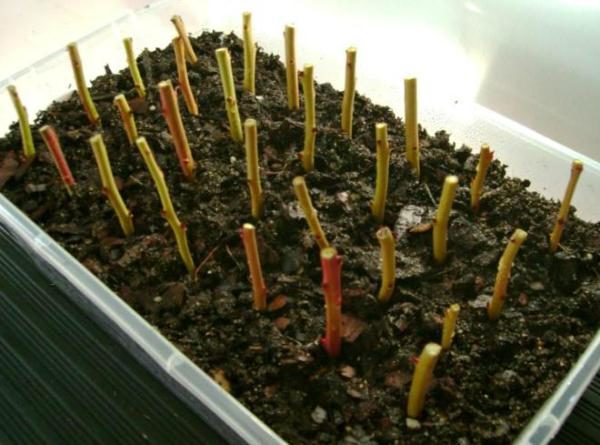

Propagation by lignified cuttings
Cuttings cut in the fall or spring are distinguished by their ability to survive. Green cuttings take root in 70%, and woody ones no more often than in 20%.
By dividing the bush
This method of breeding honeysuckle is also simple and affordable. The first days of March or the first days of September are considered the best time for it.
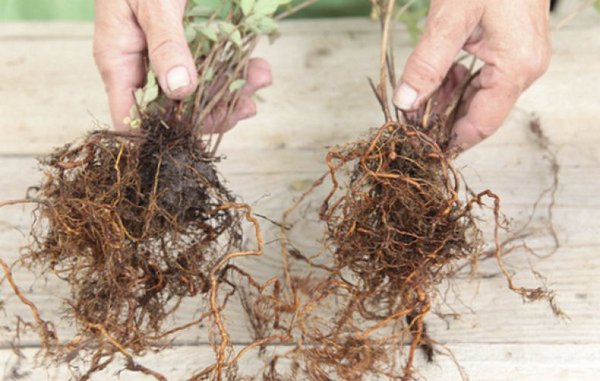

Division of honeysuckle
You can propagate a plant by dividing by following the following rules.
First, you need to dig up the selected bush and shake it off of the adhering soil.
Next, the selected number of branches is cut off, this manipulation is performed with a pruner or using a garden saw, it is important to monitor the cleanliness of the tools, they must be disinfected.
On a note! The resulting sections are treated with activated carbon or wood ash.
The last step is to land on a new selected piece of land.
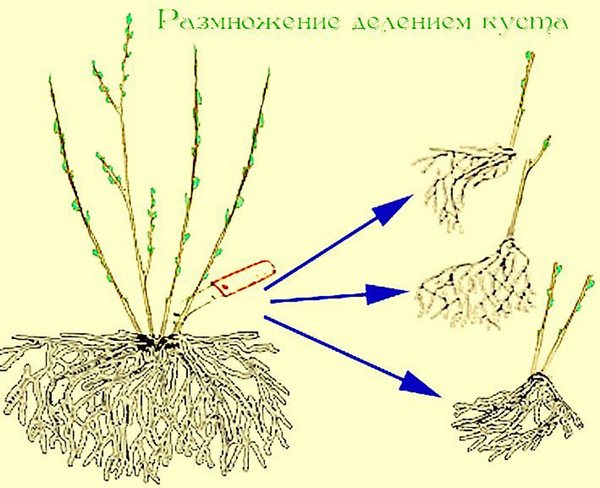

Reproduction by dividing the bush
Even a person who is not a professional in the field of gardening can easily please himself with a new type of honeysuckle, provided that all the prescribed rules for its reproduction are observed.
Breeding honeysuckle in the spring and summer. Important points
The best time to start breeding honeysuckle is spring and summer.
It is better to start rooting cuttings in the spring. After 2 weeks, most of the seedlings will be able to successfully root.
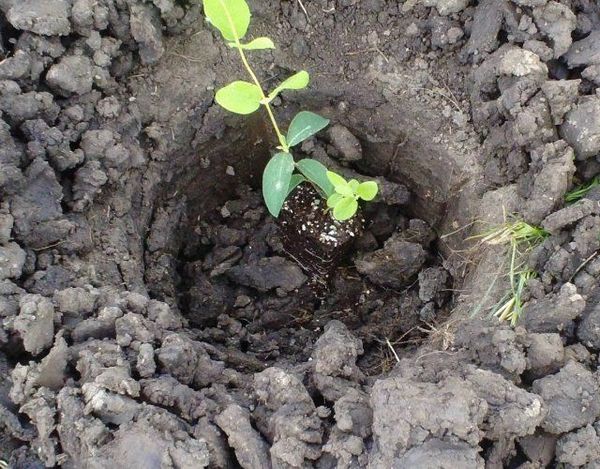

Better to plant honeysuckle in spring or summer
In the autumn period, you can start preparing seedlings that are lignified, but you need to remember that the longer they are stored, the worse the planting material will ultimately be.
On a note! Cutting is the most common and quickest way to get new seedlings from a honeysuckle bush.
It is possible to propagate the bush by division during the growing season. This option is best used after the fruit has been harvested. Spring or summer is a good time.
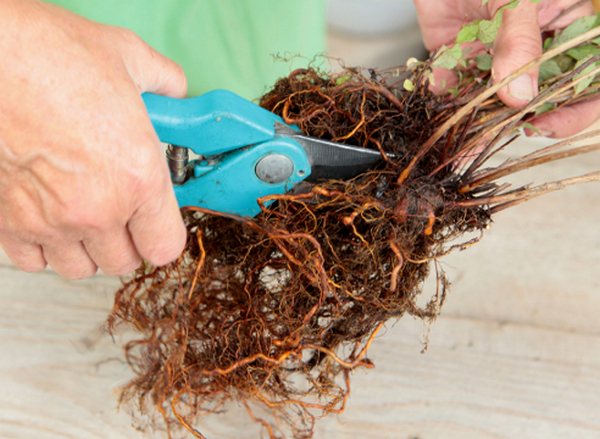

It is better to reproduce the plant after the fruits are harvested.
Further care
Cuttings and seedlings require systematic care. They must be constantly in a moist substrate, so the soil in the greenhouse must be watered so that it remains always moist, loosened regularly. During the entire rooting period, honeysuckle should be under a film that retains air humidity. The greenhouse needs to be ventilated every day.
Read also: Boiled knuckle in the oven
The care of honeysuckle seedlings includes feeding. The first is done at the time of landing, introducing 1 tbsp into the hole. l. fertilizers AVA. Then they are fed after 3 years. This fertilizer is applied to the upper soil layer 0.5 m from the projection of the crown of the bush - in this place it has suction roots. You don't need to fertilize with anything else.
It is possible to increase the number of honeysuckle bushes on the site without the help of specialized nurseries. Among gardeners, the method of obtaining planting material is considered to be common - cuttings of honeysuckle. With this reproduction, the varietal genetic properties of the mother plant are preserved. Lignified branches are harvested in autumn.
Transfer
Reproduction of currants by cuttings in spring
Honeysuckle in one place can stand for several decades. Over time, growing, the bushes begin to interfere with each other or neighboring crops. This affects the yield, so you cannot do without transplants.
When to transplant
This culture wakes up very early - the slightest thaw is enough for the buds to swell. Therefore, it is not always possible to be in time with spring transplants. Even if frosts return, the plant stops development, then wakes up again. This situation is sometimes repeated several times during the spring, so it will be difficult to guess the optimal time for transplanting.
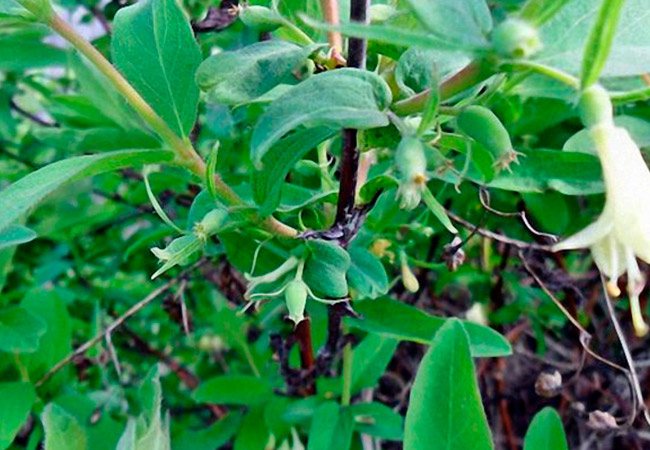

Honeysuckle preparing for hibernation
All actions should be postponed to autumn, or rather to the beginning of September for northerners (since in August the honeysuckle is already preparing for hibernation) and to October for southerners. The term is chosen in such a way that the bushes can be rooted in a new place before the onset of frost.
Reproduction by dividing the bush
Breeding by dividing the bush is quite simple. This procedure is carried out either in early March, or in the first decade of September. The scheme for dividing the bush is as follows:
- Shake the dug out bush and remove the remnants of the earth on the roots.
- Having divided the branches, proceed to cutting the bush with a sharp, pre-disinfected pruner or knife.
- Sprinkle the cut sites with activated carbon powder or ash.
- Next, you should plant the plant.
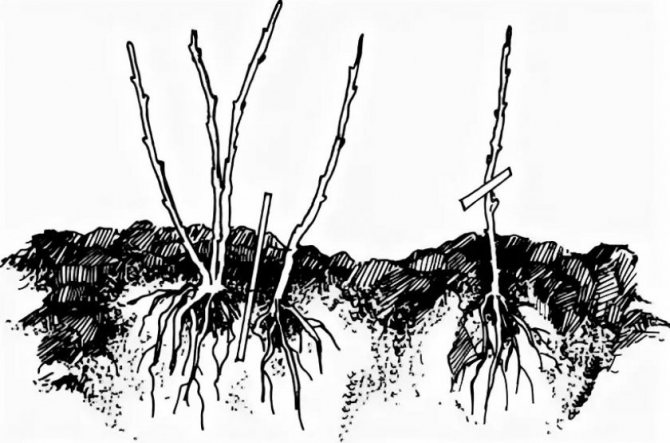

After the performed procedure, do not forget to water and loosen the soil.
Honeysuckle at a glance
The young shrub has pubescent branches, the leaves of which have a green color and a purple tint of varying intensity. In an old tree, peeling of the bark is observed. Flaking occurs in strips along the stem, before which the bark becomes gray-brown.
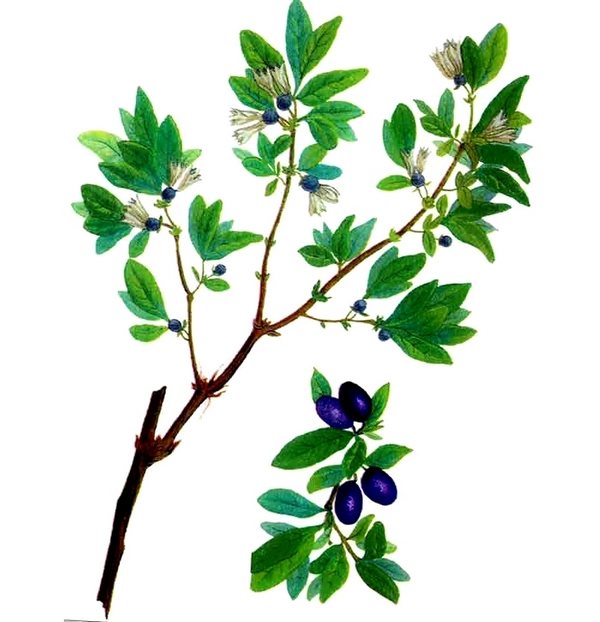

Honeysuckle structure
The leaves of the shrub are lanceolate, 6-9 cm long. The tops of the leaves are pointed. Honeysuckle leaves are recognizable due to disc-shaped stipules, they grow together with petioles, young leaves are densely pubescent.
On a note! As the plant matures, the pubescence disappears or takes the form of individual bristles.
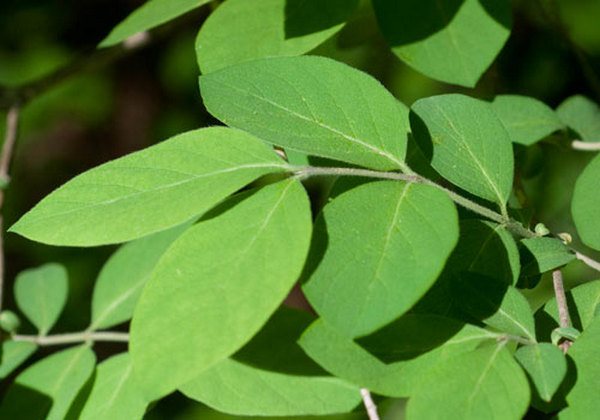

Honeysuckle leaves
The flowers of the plant resemble a funnel, the corolla is yellow. The flowers are grouped in pairs and are located in the leaf axil. The flowering period of a shrub directly depends on its location and varietal affiliation. This period begins in mid-May and lasts until mid-June.
Honeysuckle has fruits of the following form:
- round;
- oblong-cylindrical;
- cylindrical with an oblique cut at the bottom;
- in the form of an ellipse and others.
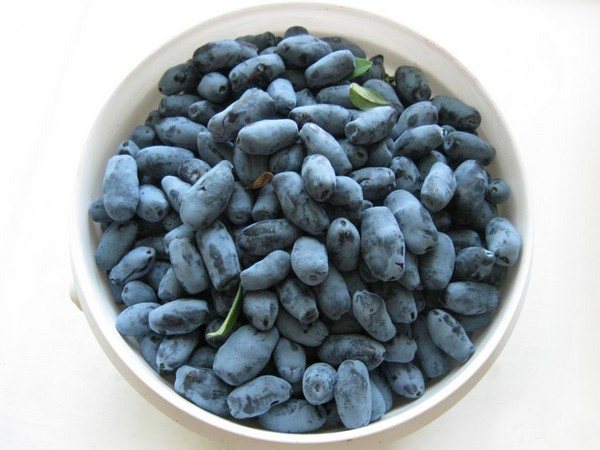

Honeysuckle fruits can be of different shapes.
Honeysuckle berries have a rich purple color, they have a whitish bloom, and a dark blue color of the fruit is also found. The inside of the berries is red-purple in color. Honeysuckle with yellow fruits is found in nature.
On a note! The seeds are brown in color, their diameter is up to 2 mm.

